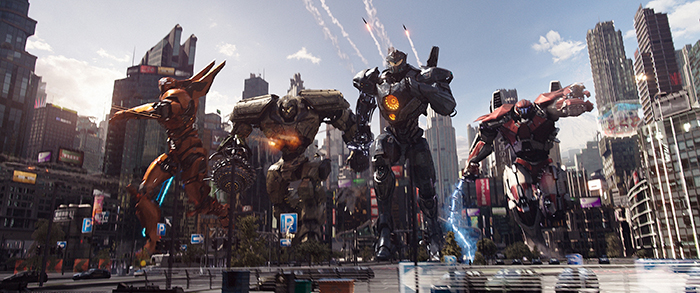 (L to R) Jaeger mechs Saber Athena, Bracer Phoenix, Gipsy Avenger and Guardian Bravo in PACIFIC RIM UPRISING. Photo courtesy of Legendary Pictures/Universal Pictures. © 2018 Universal Studios. ALL RIGHTS RESERVED.
(L to R) Jaeger mechs Saber Athena, Bracer Phoenix, Gipsy Avenger and Guardian Bravo in PACIFIC RIM UPRISING. Photo courtesy of Legendary Pictures/Universal Pictures. © 2018 Universal Studios. ALL RIGHTS RESERVED.Photos and Information for Upcoming "Mechs vs. Giant Monsters" Movie Source: Universal Pictures, Legendary Pictures Official Site: pacificrimmovie.com #JoinTheUprising #PacificRimUprising
SPOILER WARNING: This article contains plot details and images from an upcoming movie.
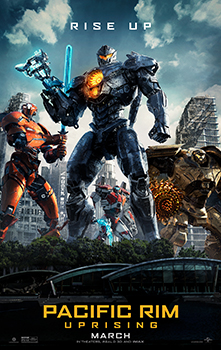 Theatrical poster, courtesy of Legendary Pictures/ Universal Pictures. © 2018 Universal Studios. ALL RIGHTS RESERVED.
Theatrical poster, courtesy of Legendary Pictures/ Universal Pictures. © 2018 Universal Studios. ALL RIGHTS RESERVED.The globe-spanning conflict between otherworldly monsters of mass destruction and the human-piloted super-machines built to vanquish them was only a prelude to the all-out assault on humanity in PACIFIC RIM UPRISING. JOHN BOYEGA (STAR WARS series, DETROIT) stars as the rebellious Jake Pentecost, a once-promising Jaeger pilot whose legendary father gave his life to secure humanity’s victory against the monstrous “Kaiju.” Jake has since abandoned his training only to become caught up in a criminal underworld. But when an even more unstoppable threat is unleashed to tear through our cities and bring the world to its knees, he is given one last chance to live up to his father’s legacy by his estranged sister, Mako Mori (RINKO KIKUCHI, BABEL) -- who is leading a brave new generation of pilots that have grown up in the shadow of war. As they seek justice for the fallen, their only hope is to unite together in a global uprising against the forces of extinction. Jake is joined by gifted rival pilot Lambert (THE FATE OF THE FURIOUS’ SCOTT EASTWOOD), as well as the courageous and conflicted Jules Reyes (ADRIA ARJONA of EMERALD CITY) and 15-year-old Jaeger hacker Amara (newcomer CAILEE SPAENY), as the heroes of the Pan Pacific Defense Corps (PPDC) become the only family he has left. Rising up to become the most powerful defense force to ever walk the earth, they will set course for a spectacular all-new adventure on a towering scale. Also reprising their roles from PACIFIC RIM are BURN GORMAN and CHARLIE DAY as Dr. Hermann Gottlieb and Dr. Newt Geiszler, two of the most brilliant scientists the world has ever seen... now both on the frontlines of Kaiju defense as part of the original team that closed the Breach. Additional newcomers to the series include JING TIAN (THE GREAT WALL) as Shao Liwen, CEO of Shao industries and a believer in an unmanned drone Jaeger corps, and Chinese superstar MAX ZHANG as Marshal Quan, the team’s laser-focused supervisor. Building on the incredible visual world that GUILLERMO DEL TORO (THE SHAPE OF WATER, PAN`S LABYRINTH) and TRAVIS BEACHAM (CLASH OF THE TITANS, PHILIP K. DICK’S ELECTRIC DREAMS) created in the first film, PACIFIC RIM UPRISING features a next-generation battleground: new Jaegers and new Kaiju, offering a state-of-the-art spectacle built for the big screen. Joining director STEVEN S. DEKNIGHT (Netflix’s DAREDEVIL, STARZ’s SPARTACUS) and producers MARY PARENT (KONG: SKULL ISLAND, PACIFIC RIM), CALE BOYTER (upcoming DETECTIVE PIKACHU), del Toro, Boyega, FEMI OGUNS, THOMAS TULL (JURASSIC WORLD, PACIFIC RIM), and JON JASHNI (UNBROKEN, PACIFIC RIM) behind the camera are a talented group of creative collaborators. They include director of photography DAN MINDEL (STAR WARS: THE FORCE AWAKENS), production designer STEFAN DECHANT (KONG: SKULL ISLAND), editors ZACH STAENBERG (ONCE UPON A TIME IN VENICE), DYLAN HIGHSMITH (STAR TREK: BEYOND) and JOSH SCHAEFFER (MOLLY`S GAME), costume designer LIZZ WOLF (TRUE MEMOIRS OF AN INTERNATIONAL ASSASSIN) and composer LORNE BALFE (13 HOURS). ERIC MCLEOD (KONG: SKULL ISLAND) serves as the film’s executive producer. PACIFIC RIM UPRISING is based on the characters created by Beacham, and it is written by DeKnight & EMILY CARMICHAEL (THE ADVENTURES OF LEDO AND IX), & KIRA SNYDER (THE HANDMAID`S TALE) and T.S. NOWLIN (THE MAZE RUNNER).
 Jaeger mechs Saber Athena, Bracer Phoenix, Gipsy Avenger and Guardian Bravo. Photo courtesy of Legendary Pictures/Universal Pictures. © 2018 Universal Studios. ALL RIGHTS RESERVED.
Jaeger mechs Saber Athena, Bracer Phoenix, Gipsy Avenger and Guardian Bravo. Photo courtesy of Legendary Pictures/Universal Pictures. © 2018 Universal Studios. ALL RIGHTS RESERVED.ABOUT THE PRODUCTION ? Back to the Breach: PACIFIC RIM UPRISING Begins In PACIFIC RIM, a Breach opened at the bottom of the Pacific Ocean, and through it emerged giant Kaiju, monsters engineered by the alien Precursors to move from dimension to dimension terraforming planets -- exterminating the indigenous species and taking full territorial control. These Kaiju unleashed their fury on coastal cities along the Pacific Rim, and proved virtually unstoppable with conventional weapons. Giant robotic warriors called Jaegers -- piloted by humans connected by a neural bridge -- were engineered to fight back. Jaeger Gipsy Danger successfully closed the Breach by detonating a nuclear bomb, helped by legendary Jaeger Marshal Stacker Pentecost, who gave his life to ensure the success of the operation. PACIFIC RIM UPRISING continues the mythology of a richly detailed, wholly original sci-fi universe. With a focus on complex, richly diverse characters, the film is a global adventure -- taking the audience from the slums of a future Los Angeles, to China, Tokyo, Australia and deep into the icy reaches of Siberia. With multi-generational and multi-cultural appeal, this is an emotionally charged, visually spectacular film about the battle for our planet and inspiring human heroism on a whole new scale. It is the year 2035, 10 years after the events of the first film, in which humanity supposedly defeated the threat of the Kaiju. The war is over. The Breach, the gateway beneath the Pacific Ocean that spawned the Kaiju, has been closed, but the fear that these unrelenting beasts from another dimension may somehow rise again is ever-present. Vigilance has become a way of life, and the PPDC has been reborn as a global force of highly advanced robotic warriors, with a new generation of young pilots at the helm. When an even more deadly Kaiju threat emerges, these young fighters -- dubbed the Cadets -- are powered by a drive to avenge and to protect what is left of the world they inherited. Earth has had a chance to repair, but is in a state of heightened tension. In Los Angeles, Jake Pentecost, son of Stacker Pentecost and a former star Academy pilot, is now a black market scavenger for Jaeger parts. While trying to steal a highly valuable tertiary plasma capacitator, he encounters young Amara, an orphan of the Kaiju War who found out the hard way that the PPDC Jaegers weren’t just going to show up and save her, so she built her own: Scrapper. With a highly gifted engineering mind, she built her mech guardian angel with parts scavenged from the Santa Monica aftermath.
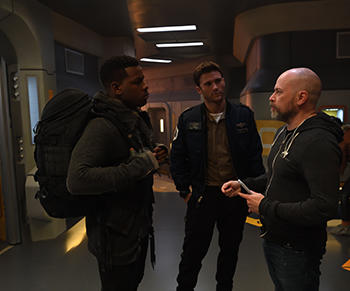 JOHN BOYEGA as Jake, SCOTT EASTWOOD as Lambert and director STEVEN S. DEKNIGHT on the set. Photo courtesy of Legendary Pictures/Universal Pictures. © 2018 Universal Studios. ALL RIGHTS RESERVED.
JOHN BOYEGA as Jake, SCOTT EASTWOOD as Lambert and director STEVEN S. DEKNIGHT on the set. Photo courtesy of Legendary Pictures/Universal Pictures. © 2018 Universal Studios. ALL RIGHTS RESERVED.Newly arrested, Jake is given the option -- by his estranged adoptive sister and high-ranking PPDC official Mako Mori -- of having a long list of charges dropped. One condition: he must agree to help train the young cadet Cadets at the Moyulan Shatterdome in China, alongside his former friend and now rival, Nate Lambert. Two men who were once closer than brothers, their relationship was damaged when Jake walked away from their shared destiny of being great Jaeger pilots. The PPDC is not only training these Cadets, but building an advanced new breed of Jaegers in case the Kaiju ever return. A rival drone Jaeger program, developed by Liwen Shao and her company Shao Industries is also now in play. It would take the pilots out of the Jaegers and control the machines remotely, causing conflict and resentment for the pilots and cadets. While the Cadets are training to fight off the Kaiju, a new enemy appears at the 10-year end of war celebrations in Sydney in the form of a sleek and devastating rogue Jaeger, Obsidian Fury -- a terrifyingly powerful opponent that Gipsy Danger will be lucky to survive. The new drones turn on their makers, igniting an unexpected Jaeger-versus-Jaeger conflict and sending the PPDC and the Cadets on a quest to find out who or what is giving this new threat a deadly edge that makes it nearly impossible to defeat. As the Jaegers go to war, a hidden threat like nothing humanity has seen triggers multiple Breaches to open up across the Pacific Rim, and the Kaiju return, more massive and more dangerous than ever. Jake and Lambert must determine how the new otherworldly threat is tied to the rogue mechs before it is too late... as Amara and her fellow recruits must defy youth and inexperience in the battlefield to defend our world. In approaching the second chapter in the series, Legendary wanted to ensure that they were crafting an innovative vision, one that, while honoring the first film, would present a bold new interpretation of the PACIFIC RIM universe. Producer Cale Boyter reflects: “Legendary has always had a signature attitude in everything that we do, and this was the opportunity to create a perfect representation of what the brand represents, and how it wants it to evolve.” It was important to the production team that no film exist without the perfect story. “There’s a lot of cynicism towards sequels,” Boyter admits, “and we were conscious of that. We had to ask ourselves ‘How do we create something that is going to take people by surprise?’” An important step for producers Mary Parent and Boyter was bringing in Steven S. DeKnight, known for creating and running the hit Starz television series SPARTACUS, as well as running the first season of the Marvel/Netflix series DAREDEVIL. DeKnight understood Legendary’s commitment to innovative storytelling, and pitched a compelling tale that checked a lot of boxes for the producers. Within this universe of monsters and mechs was a core human message and compelling emotional story arcs. “Steven is a genre blender,” commends Boyter. “In his concept, the story didn’t function like a simple sequel to PACIFIC RIM. The big idea that he started with was that anybody can make a difference. Taking that core message, the story focuses around Stacker Pentecost’s troubled son Jake, and the young, orphaned mechanical genius Amara alongside him -- two broken people who overcome their situations and their mistakes, and end up making an enormous difference.” The story would also introduce a new generation of pilots -- the cadets nicknamed the Cadets, teenagers who have been intensively training to be Jaeger pilots since they were small kids. It would also create intrigue around the return of the Kaiju, and if this return may have been facilitated by rogue human intervention. Boyter says: “The script we developed has the incredible, big action elements and the human arc around Jake and Amara, but is also a mystery adventure story. It’s 10 or 15 minutes into the picture before you realize you’re in the PACIFIC RIM world. The tone and the pace would not just be more emotional, but more kinetic.” Legendary -- buoyed by returning fellow producers del Toro, Thomas Tull and Jon Jashni -- would team up with Universal Pictures, engaging with the studio early in the creative process. Boyter explains: “We walked Universal through what we were doing. We created a pre-visualization presentation and showed them concepts and key moments from the movie, and they loved it. It made them enthusiastic about what we were embarking on together.”
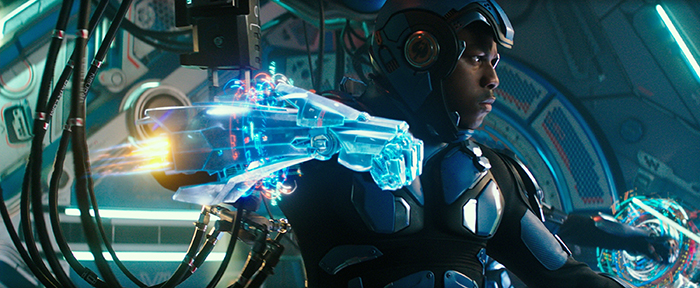 JOHN BOYEGA as Jake Pentecost in the Gipsy Avenger Conn-Pod. Photo courtesy of Legendary Pictures/Universal Pictures. © 2018 Universal Studios. ALL RIGHTS RESERVED.
JOHN BOYEGA as Jake Pentecost in the Gipsy Avenger Conn-Pod. Photo courtesy of Legendary Pictures/Universal Pictures. © 2018 Universal Studios. ALL RIGHTS RESERVED.? Enter Jake Pentecost: Boyega Joins the Production With production greenlit, one of the next vital questions to answer was who would play the lead role of Jake, wayward son of the legendary war hero Stacker Pentecost? For DeKnight and the film’s producers, one actor immediately rose to the top of the list: John Boyega. Boyega, the breakout star of STAR WARS: THE FORCE AWAKENS, wasn’t simply interested in acting in his next project. He felt that if he would give the time and energy necessary to be on set, then he would want to serve as an on-set producer. He recalls: “I had set up my own production company and went to Hollywood to introduce myself. One of the scheduled meetings was at Legendary, with Mary Parent and Cale Boyter. We talked about various projects, but at one point Mary said ‘We’re looking to do a sequel to PACIFIC RIM. Would you be interested in taking a look at a few things?’ “I said ‘yes, of course’ and we went into the room next door where they had this incredible concept art on display, depicting me in this incredibly designed suit,” he continues. “It was a fully developed pitch with Cale showing me all the amazing new elements for the film, featuring me.” He laughs, “They cornered me, I have to say!” PACIFIC RIM had made a big impression on Boyega, in the days before he broke out as a star. “Seeing Idris Elba in the first film was very important to me. At the time I was involved in acting on a small scale in drama clubs, and in 2013 I saw a print ad while I was on the bus -- Idris Elba as Stacker in an all-black Jaeger suit. The image, and what it represented, immediately struck me and motivated me.” DeKnight offers that he couldn’t have been more excited at the choice: “I was thrilled when I found out that John was interested. I met with him, and we were both very excited about the possibilities of what we could do with the franchise. He’s a classic hero, but can play the hero and the anti-hero at the same time. Jake Pentecost starts out as a thief and ends up saving the world. John has all the qualities you would want for that type of role; he’s charming, smart and funny. He brings a real Harrison Ford as Indiana Jones quality to the character.” Boyter adds: “John immediately got it, and it’s a great feeling when you have an actor like him who understands what the mission is, and then helps evolve that game plan almost every day.” The film opens with Jake, under the cover of night, involved in a nefarious activity: stealing Jaeger parts from a PPDC scrapyard. He’s caught and presented with two options: face incarceration, or use his natural talents at the Moyulan Shutterdome, training young cadets. On his character, Boyega expands: “Jake’s personality is nuanced and conflicted. He grew up in the shadow of his father, Stacker, and he’s battled with living up to the family name. He had aspirations to be a Jaeger pilot, and began training at the PPDC Academy, but they were halted after a confrontation with Stacker led him to rebel and follow a dangerous path. What follows that is his journey to becoming a hero.” Boyega wanted Jake to possess an element of Stacker in terms of presence, energy and authority, but to be someone very different; for audiences to recognize the rebel in him that Stacker didn’t agree with. “That’s something that I decided to create based on how I saw myself when I was 16 and 17 -- a cocky kid with a little bit of mismanagement.” The multi-talent welcomed his dual rule over the course of the massive production. “In my previous films, I was just an actor,” Boyega says. “Now I’d be a producer as well, and I loved the challenge of having to live up to that form of leadership, co-producing alongside a studio that I admire, acting in a fantastic role, and working with Steven -- someone I’ve wanted to work with after his incredible work on SPARTACUS and DAREDEVIL.” “One of the reasons why he is so great is because he’s collaborative, and his notes are accurate to character,” continues Boyega. “I’ve been blessed in my career to meet directors who have a great balance between technical knowledge and artistic knowledge, and Steven has a way of directing to make it all feel seamless. It felt like we worked as one. He’s fantastic.” The dual role of star and producer presented complex challenges for Boyega, which in the end could enhance the entire production. “Being a producer was interesting because any decision I helped make outside the character affected the role. When it came to casting the other actors, when it came to set pieces, action sequences, dialogue, it was all a jigsaw puzzle in which I had to make decisions and give opinions to support the character I felt needed to be created.” Boyter points to the actor’s particular skill in creating the necessary empathy required by the role. “The tone and the humanity John brought were vital. He’s such an accomplished actor -- he can make you care, he has a charm such that his character can do morally questionable things, but you still love him, which is so important of course in telling a redemption tale.” That inspirational reaction the young Boyega had, on seeing Elba in the PACIFIC RIM poster a few years earlier, would be key to the overall impact the film sets out to have on its audience. “Ultimately, the film is about people coming together to fight for a common good,” shares DeKnight. “It doesn’t matter where you came from -- everybody has a chance to make a difference. Everybody has a chance to be a hero. That was a message that strongly spoke to all of us working on this movie, and we wanted to convey that to the younger audience.”
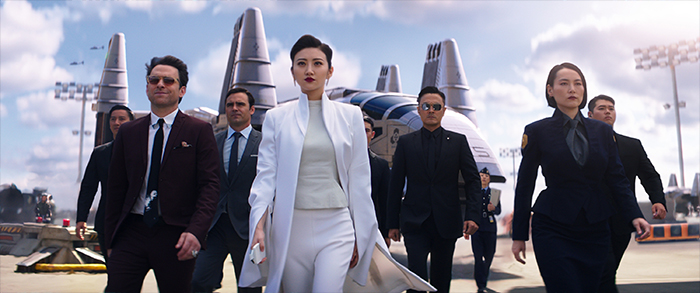 (L to R, center) Dr. Newt Geiszler (CHARLIE DAY), Shao Liwen (JING TIAN) and Mako Mori (RINKO KIKUCHI). Photo courtesy of Legendary Pictures/Universal Pictures. © 2018 Universal Studios. ALL RIGHTS RESERVED.
(L to R, center) Dr. Newt Geiszler (CHARLIE DAY), Shao Liwen (JING TIAN) and Mako Mori (RINKO KIKUCHI). Photo courtesy of Legendary Pictures/Universal Pictures. © 2018 Universal Studios. ALL RIGHTS RESERVED.? Pilots and Warriors: Key Cast of the Epic Adventure PACIFIC RIM UPRISING features a diverse blend of favorite characters and exciting new faces, to reward both fans and new audiences alike. The focus in character and casting was on diversity. Humanity unites in the film, ignoring religion, race or background, and director DeKnight and the producers wanted to reflect that ethos in the cast of the film. “The global aspect of this story is what drew me to doing it,” says DeKnight. “The Pacific Rim touches so many different countries, and we wanted to reflect that. We didn’t want it to feel forced; it’s very organic that the world comes together to fight this global threat, that encourages everyone to put aside their differences, which is a fantastic message for this day and age.” In first film, Stacker Pentecost brought in Mako Mori to become part of their family, which ultimately caused tension for the young Jake. Boyega explains: “After Stacker took in Mako, the trajectory changed. Jake and Stacker couldn’t see eye to eye, and Mako was caught between the two. It was hard for Jake to live in the household knowing that Mako lived up to Stacker’s image of an ideal child, and that tension led to Jake leaving.” It’s Mako’s belief in her adoptive brother’s capabilities, and events surrounding her, which propel Jake down the hero’s path. Young Amara, whom he encounters in the film’s opening sequence and with whom he is dispatched to the Shatterdome, is also vitally important in Jake’s growth. Boyter says: “There’s a lot of stuff that Jake has to overcome, but playing the father figure to Amara helps him to open up and let go of the frustration and the pain that he felt toward his own father.”
 JOHN BOYEGA as Jake and SCOTT EASTWOOD as Lambert. Photo courtesy of Legendary Pictures/Universal Pictures. © 2018 Universal Studios. ALL RIGHTS RESERVED.
JOHN BOYEGA as Jake and SCOTT EASTWOOD as Lambert. Photo courtesy of Legendary Pictures/Universal Pictures. © 2018 Universal Studios. ALL RIGHTS RESERVED.Nathan Lambert is a PPDC Ranger, one of the best pilots in the fleet, and heads up the training program for the Cadets, instructing and grooming the young, precocious cadets. Lambert and Jake grew up and trained together, and were best of friends until Jake ran away from the PPDC without a word to his compatriot. In PACIFIC RIM UPRISING, the two have no choice but to heal, or ignore, their past -- their combined talents are vital to combatting the rogue mechs and Kaiju. Of the relationship, Boyega shares: “Lambert was hurt by Jake deciding to leave and not explain himself. When they face each other again, Lambert says ‘You can’t just go in and out of my life and not value me as a friend, as your brother.’ They’re trying to work out how to get back to where they were.” His methods are rigid and smack of hard love, but for good reason. Eastwood, who portrays Lambert, states: “He’s very sure of himself, very set in his beliefs. He’s not hard on them for no reason; he’s trying to train these young kids to one day defend lives. There’s not a lot of room for pleasantries when it comes to life and death.” Eastwood was drawn to the characters and their story arcs, not just by the impressive action sequences. “You can have all the big visual effects, but if you don’t have characters that you can fall in love with, then you’re disconnected during the big action scenes,” he sums. “If you’re able to go on a journey with them, it makes it a far more powerful film for the audience.” The actor also appreciated the vulnerability during the battle scenes. “What I love about the film is that you’re wearing these suits and operating these Jaegers, but you’re still just a human being. You don’t have special powers; you can get hurt or die. You’re just a human trying to fight in this war. I thought that was interesting. It wasn’t mystical; it was based in reality.” Orphaned during the Kaiju attacks a decade prior, Amara lives alone in an abandoned building in Santa Monica. Street smart and with a fiery personality, she’s driven by the fierce need to be prepared when the Kaiju return. In a situation that would defeat many, she nurtured her extraordinary innate engineering talent, building her own Jaeger, Scrapper, from spare parts. Newcomer Cailee Spaeny, who portrays Amara, had previously acted in short films but lives far from major filmmaking centers. The Springfield, Missouri, native’s audition for PACIFIC RIM UPRISING was self-taped, but rather than simply standing in front of a white wall reading lines... she went all out to create an effective audition. “Because I don’t have a lot to do in my small town, I took a whole day to prepare,” the young performer reflects. “The air conditioning wasn’t working, so I was really sweating, I had a hood on, dirt on my face and I was rolling around on the floor with a pipe in my hand, with television remotes as Scrapper buttons and a stepstool to get into the Conn-Pod. When I sent the tape off, I thought they might think I’m crazy... or they might love it!”
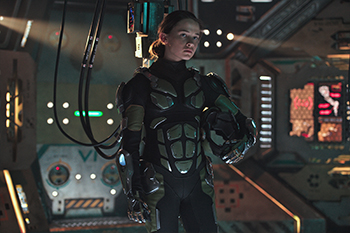 CAILEE SPAENY as 15-year-old Jaeger hacker Amara. Photo courtesy of Legendary Pictures/Universal Pictures. © 2018 Universal Studios. ALL RIGHTS RESERVED.
CAILEE SPAENY as 15-year-old Jaeger hacker Amara. Photo courtesy of Legendary Pictures/Universal Pictures. © 2018 Universal Studios. ALL RIGHTS RESERVED.DeKnight and the producers were intrigued by the young actress’ talent and inventiveness, and a week later flew Spaeny out to Los Angeles. “I met Steven, then had a day to take in his notes and prepare before I read with John. It was something I’d never experienced before, leaving an audition, feeling like I’d been working with a team. In a lot of auditions, you feel like the pressure is on you, but I didn’t feel like that with Steven and John. It was very collaborative, and I got out of the room and thought: ‘I have no idea if I’m going to get this part, but that was the most fun I’ve ever had.’” Amara first encounters Jake when he pursues her after she steals an expensive Jaeger part he’s been after. They fight, before they both pilot Scrapper in an attempt to avoid capture. Keenly aware of Amara’s engineering talent, Mako sends her to the Moyulan Shatterdome alongside Jake, to train with the Cadets. Both Amara and Jake are used to self-sufficiency, and they pull away from each other, but their many similarities lead them to form a bond. Spaeny explains: “People have been taken away from them, so they’ve closed themselves off. It’s a challenge for them to work with others. They don’t know how to do that, but when they find a way to do that, they are the perfect team.” Of the burgeoning friendship between the two, Boyega explains: “When they arrive at the Shatterdome, they help each other navigate through an environment that Amara doesn’t understand fully yet, and that Jake has lost touch with. They find a sibling relationship with each other, where Jake becomes an older brother to her.” Spaeny singles out Boyega for going above and beyond, on set and off set. “John took me under his wing; he wanted to help me in this process. Jake is very jaded, and John’s the complete opposite. He’s an amazing person, and I got so lucky that he is an actor I now look up to.” Her co-stars were equally impressed by the work of the newcomer. Boyega praises: “Cailee’s innocence allowed for this fresh way of approaching her breakout role. That’s something that Cailee handled very well. As much as I’ve done, I learned from her and we genuinely had a strong bond and great chemistry.” Eastwood adds: “Cailee’s incredible. She lights up the screen. She’s got a big career ahead of her. She brings that young innocence, but she has something about her that you can’t put your finger on. She was so honest in her performance.” When Mako lost her parents during a Kaiju attack years ago, she was saved by Stacker Pentecost, who adopted her. Mako became a student in the Jaeger Program, where she trained to become a Ranger with an exceptional record. At the end of the first film, she and Raleigh teamed up to pilot Gipsy Danger, and saved the world from the Kaiju. In PACIFIC RIM UPRISING, Mako holds the rank of Secretary General at the PPDC and offers her estranged brother the choice to avoid jail time by helping train the Cadets. Mako knows that Jake is a great pilot and she finds a way to lead him back. Japanese actress Rinko Kikuchi, who returns to the role, says of the character’s transition to the new film: “Over the past 10 years, Mako has had to struggle with the sadness of her past. She lost people she loved, so she’s always been brave and tough, but now she’s tougher.” Regarding Mako’s faith in her little brother, Boyega asserts: “Mako’s belief is that Jake can become a good leader himself, he could be the best version of himself if he just tried. Her unwavering belief motivates him to turn his back to the mistakes that he made and step up to become the man that she knows he is.” Of collaborating together, Kikuchi says: “John was perfect for the role. It was great fun to work with him, playing off that sister and brother relationship.” She has equally kind words when it comes to working with director DeKnight: “Steven gave me his thoughts about Mako’s character and enough time for me to then find my character on set. He brought his vision without changing the PACIFIC RIM universe.” Another powerful player on the frontline of Jaeger defense is Liwen Shao. She is the founder and owner of Shao Industries, a private innovation company created with the goal of protecting the world from future Kaiju threat. She’s ruthless, clinical and incredibly determined; it seems that nothing will stop her from achieving her goals... and she’s willing to do anything to reach them. Liwen’s primary drive and focus is to have her drone Jaeger program implemented by the PPDC. She’s designed a brilliant feat of engineering by which a single pilot can operate the drone via a remote link, side-stepping the need to find and train drift-compatible pilots. She sees the program as a chance for cooperation with the existing Jaeger pilots; they see it as a chance to shut them down. Chinese actress Jing Tian, who portrays Liwen, feels that her character “is a genius. Very few people on the planet can match her intelligence and work ethic. Having been the victim of the original Kaiju attacks, Liwen has devoted her life to stopping future ones. While she’s amazingly successful professionally, socially she comes off as cold and unfriendly.” The performer reflects: “Liwen is a very powerful and successful character, but she has her flaws.”
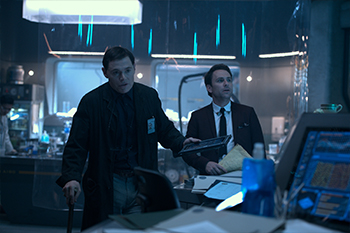 Dr. Hermann Gottlieb (BURN GORMAN) and Dr. Newt Geiszler (CHARLIE DAY). Photo courtesy of Legendary Pictures/Universal Pictures. © 2018 Universal Studios. ALL RIGHTS RESERVED.
Dr. Hermann Gottlieb (BURN GORMAN) and Dr. Newt Geiszler (CHARLIE DAY). Photo courtesy of Legendary Pictures/Universal Pictures. © 2018 Universal Studios. ALL RIGHTS RESERVED.In the first chapter, Dr. Newton Geiszler, or “Newt” for short, worked at the PPDC, becoming the foremost expert on the Kaiju. The scientist was able to devise a way for humans to drift with Kaiju brains, discovering the true nature of the Kaiju and the Precursors, and eventually helped to close the Breach. In PACIFIC RIM UPRISING, Newt has moved into the private sector, working for Shao Industries as head of research and development. He’s rewarded for his important research on the drone project with a large salary, but must work under Liwen’s steely thumb. As a result of the unexpected attack by the rogue Jaeger Obsidian Fury, Liwen forces Newt and his team to deploy the drones earlier than scheduled -- perhaps too early. Performer Charlie Day, who returns to the role, says: “It’s nice to be able to bring that knowledge of my character and all his history to the second film. I hope that audiences will be excited to see our characters return, as well as to meet the new ones... and to go on a breathtaking new adventure.” In PACIFIC RIM, Gottlieb was a fellow scientist partnering alongside Newt in the trenches. Under pressure and with little funding, they worked tirelessly to do the best they could. While Newt has moved into the private sector, Gottlieb has remained at the PPDC. Still, with more robust funding he devises innovative chemical and biological ways of advancing our defenses against future Kaiju attacks. As the film opens, Gottlieb is working on a Kaiju blood-reactive fuel system, but needs his old friend’s expertise to balance the equation, knowledge that Newt isn’t keen to share. Gottlieb’s insightful discoveries will prove crucial to later events. Burn Gorman, who returns to the role of Dr. Hermann Gottlieb, shares: “Gottlieb is great fun to play, because he’s spiky and opinionated, but ultimately has a heart of gold. He’s now respected and able to access the resources he needs, so we find him in a better place, but he’s working without Newt and misses him. He’s a lonely, eccentric character, a cerebral guy who’s led by the search for answers. His communication skills are terrible, but he means well.” Of the split between Newt and Gottlieb, Gorman says: “One of the reasons that the relationship is more complex in this film is because Newt has gone into the private sector and there’s a certain amount of hurt. He hasn’t found anyone who matches him for enthusiasm and knowledge, and Newt is very clever man.” Another key player in the PPDC is Jules, a J-Tech and mechanic at the Moyulan Shatterdome. Charged with running a team that keeps the Jaegers in perfect condition, she’s the object of Lambert’s affections. Not surprisingly, when Jake Pentecost arrives, he’s also drawn to her power and confidence.
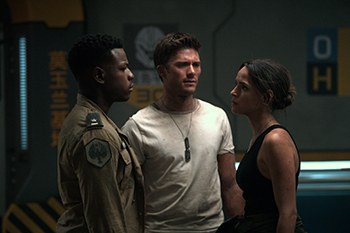 JOHN BOYEGA as Jake, SCOTT EASTWOOD as Lambert and ADRIA ARJONA as Jules Reyes. Photo courtesy of Legendary Pictures/Universal Pictures. © 2018 Universal Studios. ALL RIGHTS RESERVED.
JOHN BOYEGA as Jake, SCOTT EASTWOOD as Lambert and ADRIA ARJONA as Jules Reyes. Photo courtesy of Legendary Pictures/Universal Pictures. © 2018 Universal Studios. ALL RIGHTS RESERVED.Puerto Rican actress Adria Arjona, who portrays the mech, says: “Jules is definitely a fixer. She’s very strong, reacts quickly and decisively, and has very little room for distraction. She has her guard up, but when she lets it down you can see that she’s as soft as everyone else.” To understand Jules’ world, Arjona visited the USS Midway in San Diego and was guided through the mechanical workings of fighter planes. The presence of strong female characters in the screenplay immediately struck Arjona: “The first thing I felt when I read the script was that there were very strong male leads, but that the characters who carry the film are the females.” The actress recognized that there was much to relate to in the film for different audiences. “That’s a special thing in such a big movie,” she proudly states. “Little girls will be able to watch it and relate to it, and so will 40-year-old men. You have strong girls, not chasing after a guy but working with and leading these men, and the men respecting them. Jules is a strong woman who is good at her job, and I think that this will prove to girls, including Hispanic girls, that it’s okay to have an opinion. It’s okay to be strong. There’s nothing wrong with that.” Of the diversity of the cast, Arjona says: “We have a Cuban, a Puerto Rican, a girl from the States, a guy from Hong Kong, a British actor of Nigerian heritage. There were so many different people and they threw us all together and we became a little family; that shows onscreen.” She tells that the core of the production was truly their director: “Steven gave us the liberty to explore. In a production like this, it’s hard to give actors liberty, because time is money, but he did. His priority was his actors, and he let us play and improvise in a film this big. He brought something really special to the table: he gave it heart.” Last but not least, Marshal Quan is the highest ranking PPDC official at the Moyulan Shatterdome. He’s officious, efficient, and a highly capable commander. Chinese actor Max Zhang, who was cast as the Marshal, trained from a young age in martial arts, and was a wushu athlete before commencing his film career as a stunt actor in Ang Lee’s 2000 blockbuster CROUCHING TIGER, HIDDEN DRAGON -- later moving into roles that combined his athletic and acting skills. PACIFIC RIM UPRISING was Zhang’s first experience working at Wanda Studios, and its scale impressed him. “It’s a huge complex, with so many stages,” he notes. “I’m happy that the film industry has evolved so fast in China, and I hope that we can do more movies like this.” Of working with Boyega, Zhang commends: “John is like a superhero in this film, and he is very interested in the martial arts. He told me that he’d seen at least one of my former films, so I hope someday I can work with John in a martial-arts movie.”
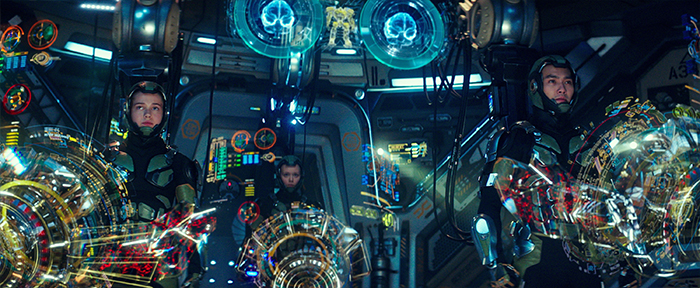 Cadets Amara (CAILEE SPAENY), Vik (IVANNA SAKHNO) and Jinhai (WESLEY WONG) co-pilot the Bracer Phoenix Conn-Pod. Photo courtesy of Legendary Pictures/Universal Pictures. © 2018 Universal Studios. ALL RIGHTS RESERVED.
Cadets Amara (CAILEE SPAENY), Vik (IVANNA SAKHNO) and Jinhai (WESLEY WONG) co-pilot the Bracer Phoenix Conn-Pod. Photo courtesy of Legendary Pictures/Universal Pictures. © 2018 Universal Studios. ALL RIGHTS RESERVED.? Meet the Next Generation: Cadets of the PPDC Given their massive size, Jaegers require multiple pilots working in tandem. Connected mind-to-mind via a neural bridge known as “The Drift,” pilots have to be “drift compatible”: achieving a state of physical and mental synchronicity with each other, through the shared connection to a Jaeger. In the first film, those united by DNA or emotional ties -- brothers, fathers and sons, husbands and wives -- were the most drift compatible. In PACIFIC RIM UPRISING, a program has been developed by the PPDC to expand how people from different backgrounds and experiences achieve synchronicity. The young cadets in this elite program are called the Cadets, and director DeKnight explains what it means to have this connection: “The idea is that if you start training someone young, they’ll become a better pilot and will form a stronger mental link with their co-pilot. The drift compatibility can be nurtured over time.” During the final act of PACIFIC RIM UPRISING, the Cadets are the only force standing between the world’s destruction from the Kaiju and its survival. These teenagers of varied backgrounds and experiences have been handpicked from different corners of the world; trained from a very young age, they must stand up and become heroes. “It’s wonderful for kids in our audience to be able to see themselves in that way,” says Boyega. “It correlates to their own lives and the obstacles they have to face. They can see in this film strength coming from people who are like them, and that anybody can be a hero. Anybody can live up to their true potential, and you see that through Amara, Suresh and all the members of the Cadets.” Spaeny was spurred on by her fellow young actors from across the globe. Truly, the performers found this tight knit unit, living and working side by side for the many months before and during the shoot. “The cadets are so passionate and driven, and they want to fight and to help the world as much as they can; the actors who played them were amazing,” Spaeny says. “We had each other’s backs, we had meals together, went to karaoke together; we’d have life talks. They’re my family now, and I’m so excited to see where all of them go.” Of the diversity, actor KARAN BRAR (Cadet Suresh, the youngest of the Cadets) says: “Steven and the producers made sure this cast was very diverse. That is incredible because, regardless of where this film goes internationally, kids can look up and look at a screen and think, ‘They’re just like me, I could be there.’ I’ve had those moments with actors who I look up to, so hopefully when this film plays in India, a kid will see me onscreen and think ‘I see someone like me up there.’” For Brar, the joy of his job during production: “was being able to make the impossible happen. We’re supposed to be in giant robots fighting giant monsters. The actors and the crew make it happen, and that’s the amazing thing about movie magic, we made the impossible happen.”
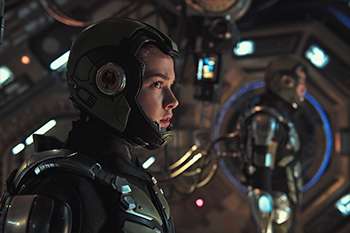 Cadets Amara (CAILEE SPAENY) and Jinhai (WESLEY WONG) in the Bracer Phoenix Conn-Pod. Photo courtesy of Legendary Pictures/Universal Pictures. © 2018 Universal Studios. ALL RIGHTS RESERVED.
Cadets Amara (CAILEE SPAENY) and Jinhai (WESLEY WONG) in the Bracer Phoenix Conn-Pod. Photo courtesy of Legendary Pictures/Universal Pictures. © 2018 Universal Studios. ALL RIGHTS RESERVED.His colleague, Cadet Jinhai grew up in a military environment in China, groomed from birth to become a part of this highly disciplined unit of cadets. One of the kindest of the corps, he becomes particularly close to Amara. “Jinhai’s parents were Jaeger pilots,” explains Hong Kong-native WESLEY WONG of his character, “so he grew up in a family environment connected to this world. Now he’s part of the Jaeger program as well.” In his first scene, Jinhai is seen doing inverted crunches off a bunk bed, so a rigid exercise and diet regime for Wong began four months before shooting. To prepare emotionally, Wong went to an ideal source. “I visited a pilot in China, who flew jets in the Air Force,” the actor says. “He told me a lot about the thoughts of someone like Jinhai, who had army parents who had to go out to fight. Now the kid is in the same position, and the pilot talked about how that would affect the kid and his parents. That helped me a lot in my preparations.” In one scene, Jinhai shares a Conn-Pod with not just one co-pilot but two -- Cadet Viktoria “Vik” and Amara -- increasing the difficulty of achieving synchronicity. “I’d rehearsed with IVANNA SAKHNO, who plays Vik, but I’d not rehearsed with Cailee. The first time all three of us were in the Conn-Pod was when we were shooting, and we said ‘Okay, let’s do this!’ Working in sequence together was completely different, but when we saw the playbacks it looked very cool.” Russian Cadet Ilya has a dry sense of humor and a seething intensity. He’s often in his own head, challenging himself to be the best, yet questioning whether he can be. Canadian actor LEVI MEADEN, who portrays Ilya, partly focused his preparation on perfecting a Russian accent. “I had a great dialect coach, and I spent a lot of time watching Cronenberg’s film Eastern Promises and reading a lot of Russian literature, Dostoyevsky mostly.” Meaden sees the Cadets as preparing for what could be, with no initial signs that danger is coming. “The Cadets were very young when the attack occurred 10 years ago, so it hasn’t had a huge influence. They grew up in a world of fear, but they didn’t understand the full gravity of the situation. The cadets have been raised to be revved up and on edge and ready to fight at any given moment.” Cadet Vik had a tough upbringing, and is constantly aiming to prove herself. Losing both parents in a Kaiju attack, it took great self-reliance and persistence to get to the training program at the Moyulan Shatterdome. It has now become her home, and the people in it her only family. The arrival of child prodigy Amara brings out a defensive edge in her. Of her character, Ukrainian actress Ivanna Sakhno says: “When Amara comes into the group, Vik becomes angered, not because she’s a bully but because she’s so protective of what she has. She doesn’t want to have it taken away from her by this young girl, with all her talent.” During the months of training before arriving on set, Sakhno researched strong females in films and in real life, to gain a deeper understand the commonalities of strong female figures. “I looked at many types of women, including politicians, for example. I watched Angela Merkel, and observed the way she acts, moves and talks. Studying women with a strong core helped me a lot in shaping who Vik is.” Ryoichi, an excitable, energetic Hopeful, is portrayed by MACKENYU MAEDA, who was shooting a television drama series in Japan when he learned that the part was being cast. “I sent in a video audition, and got a call back,” Maeda remembers. “The Japanese producers gave me 24 hours to go to Los Angeles, so I got on a plane, met with Steven, then flew back and shot again in Japan. It was bizarre to fly for such a brief meeting, but definitely worth it!” Ryoichi pilots the Jaeger Saber Athena with Cadet Renata (SHYRLEY RODRIGUEZ). “The Jaegers have become faster over the past 10 years, but Saber Athena is the fastest, so I have great pride in it,” Maeda says. “Since I was a boy, the idea of fighting Kaiju with a robot that you’re in control of was a dream, so co-piloting Saber Athena was a dream come true. Filming those scenes was hard work but incredible.”
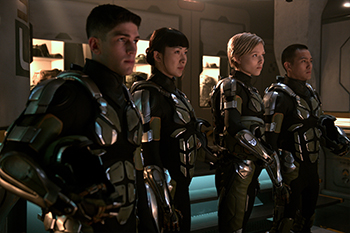 (L to R) Cadets Tahima (RAHART ADAMS), Mei Lin (LILY JI), Vik (IVANNA SAKHNO) and Jinhai (WESLEY WONG). Photo courtesy of Legendary Pictures/Universal Pictures. © 2018 Universal Studios. ALL RIGHTS RESERVED.
(L to R) Cadets Tahima (RAHART ADAMS), Mei Lin (LILY JI), Vik (IVANNA SAKHNO) and Jinhai (WESLEY WONG). Photo courtesy of Legendary Pictures/Universal Pictures. © 2018 Universal Studios. ALL RIGHTS RESERVED.Cadet Tahima is of Maltese origins, but grew up in Sydney, Australia. As with the other cadets, Tahima wants to seek revenge against the Kaiju, who displaced his family when they attacked Sydney. Australian actor RAHART ADAMS, born to parents of Maltese heritage, was cast while in Los Angeles. Of the process, he recalls: “When I read the script, it was mind-blowing because there were all these new elements of the PACIFIC RIM universe. It was a lot to wrap my head around, but was so exciting because I’d never been a part of something so big.” Like his fellow cadets, Adams was awed by the overall scale of the production. “I had to pinch myself every time I walked onto a set. Especially the night shoots with 20-foot-tall blue screens and explosions going off. The detail for everything was amazing.” Cadet Mei Lin is originally from Guangzhou, in southern China, where her parents were killed by the Kaiju during the attacks a decade ago. Chinese actress LILY JI, who portrays the character, elaborates on the backstory she created for her character: “Mei Lin then went to the Cadets’ training center; she felt she had to become a soldier to avenge her parents. She grew up alone, and has felt a lot of pain, but she’s very strong and tough.” To immerse herself in the role, Ji details: “I trained like a soldier and ate like a soldier, but I also kept a handwritten journal written in Chinese, documenting the cadets’ lives. I felt that Mei Lin’s mom, even though she was now gone, would want her to keep a handwritten journal, so it would feel like a personal, intimate diary.” Of working and bonding with the other cadet actors, Ji says: “We trained together, ate together, we watched films. We learned bits of each other’s languages, and gradually we became this family. We found ourselves bonding like the Cadets, through our daily activities.” Finally, Cadet Renata is a sporty and vivacious character. Rodriguez describes her as “sweet, but spicy. I’m Cuban-American, I’m first generation, and Steven was very open in letting us do your thing. So, I decided to make my character Cuban so I could take some of my family history and use that in crafting her... and find those elements to make her more real.” Renata derives from “born again,” and that’s what the character and the other Cadets represented to Rodriguez. “It’s a dark time, there’s a lot of uncertainty and these young people are light-bringers; they bring hope.” The aspect of the film that most impressed her, though, was its message and how crucial she sees it to the contemporary world. The actress says, hopefully: “We’re all from different places, we communicate differently, have different languages. If audiences watching PACIFIC RIM UPRISING can see that in this world we coexist and work together for a good cause... why aren’t we doing this in our real lives? When we’re children, we don’t let our differences separate us. Being different is irrelevant. The film will entertain and excite audiences, and I hope it may also help people open their eyes more to working together for a better world.”
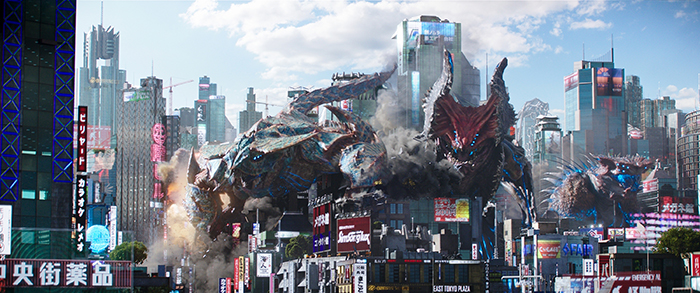 The monstrous Kaiju attack. Photo courtesy of Legendary Pictures/Universal Pictures. © 2018 Universal Studios. ALL RIGHTS RESERVED.
The monstrous Kaiju attack. Photo courtesy of Legendary Pictures/Universal Pictures. © 2018 Universal Studios. ALL RIGHTS RESERVED.? Scale and Strength: Kaiju versus Jaegers In the PACIFIC RIM universe, the Kaiju are giant monsters that erupted from the depths of the Pacific Ocean. Entering our world through the dimension-spanning portal called the Breach, they are living weapons of mass destruction, bio-engineered to terraform planets. In PACIFIC RIM UPRISING, the Kaiju evolve into a deadly and unexpected new species. In Japanese, the word “Kaiju” literally means “strange beast,” but is more commonly translated as “giant monster.” DeKnight, who grew up watching the Japanese Kaiju movies of the 1950s and ’60s, reminisces: “I loved them as a kid, back when it was the man-in-a-suit approach. What I love about doing a Kaiju film now, with the technology we have, is that we have a chance to make it that much more spectacular. As much as I love the nostalgia of those original films, even as a kid I knew it was a guy in a rubber suit stomping on miniatures. When our Kaiju attack a city, it feels completely real. The threat and the drama feel immediate.” Increasing in strength and ferocity, each Kaiju is an entirely new species with its own powers and attack patterns, perfectly evolved to do battle. While no two Kaiju are the same, they share a common goal: the extinction of the human race. In the face of this lethal foe, the Jaegers are humanity’s only defense. Being in control of a Jaeger has never been more thrilling. PACIFIC RIM UPRISING brings its heroes and the audience even closer to the action with cutting-edge technology and wildly inventive battle tactics. The film features the next generation of robotic guardians, sporting brand new weapons systems and abilities, as well as newly designed cockpits. These Jaegers stand as tall as 25-stories, and they are faster and more agile than ever before -- as well as vary in terms of scale. Each Jaeger is an extension of its pilots, and so each has a unique fighting style, movement style and personality. On DeKnight: “When we first meet Amara, she’s built her own Jaeger out of scrap. Scrapper is about 40-feet tall, so she can run it herself; although made of junk, it has the ability to curl into a ball and roll fast to get away. Amara’s also included defense mechanisms like smoke bombs -- things that a kid would think of.” In the film’s opening action sequence, Amara and Jake are forced inside Scrapper at the same time to avoid a pursuing Jaeger, and the smaller size and different capabilities give Scrapper a fun, dynamic feel. Boyega brought LIANG YANG onto the film, with whom he’d first worked on STAR WARS: THE FORCE AWAKENS, to advise on the fight sequences. He decided to think in terms of not just how humans move, but also the newly acrobatic and agile Jaegers. Boyega says: “We wanted to make sure that we could show that these skills are a very significant development from what was done in the first film. So, we brought on Liang, who is an expert in martial arts, to take a look at the pre-visualizations. Once Liang got a hand on the pre-visualizations, he built on top of the fantastic ideas that Steve had. Liang had a great collaboration with the visual effects team, and a lot of the sequences in the confrontation scenes will shock the audience.” Spaeny had to train for not only the smaller Jaeger, Scrapper, but for Gipsy Avenger. “Operating Scrapper required a skiing-type motion that I trained for weeks to perfect,” the actress explains. “It was a very specific movement, and I didn’t need to sync up with anybody else. The Gipsy Avenger Conn-Pod was more difficult. Since I had to sync up with John, who’s taller than I am, we had to figure out our relative length of steps were and how to time that out. There were a lot of rehearsals for the choreography in the Conn-Pods, on top of the fight choreography. It was a unique experience.”
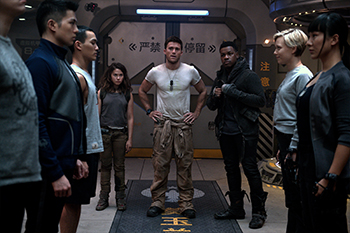 CAILEE SPAENY as Amara, SCOTT EASTWOOD as Lambert and JOHN BOYEGA as Jake with Amara`s fellow Cadets. Photo courtesy of Legendary Pictures/Universal Pictures. © 2018 Universal Studios. ALL RIGHTS RESERVED.
CAILEE SPAENY as Amara, SCOTT EASTWOOD as Lambert and JOHN BOYEGA as Jake with Amara`s fellow Cadets. Photo courtesy of Legendary Pictures/Universal Pictures. © 2018 Universal Studios. ALL RIGHTS RESERVED.Unique indeed, as the vision for the Jaegers and their interior technologies had evolved since the first film. DeKnight explains: “Inside the Jaegers, we redesigned how the pilots are connected. They’re not so bolted in, they have a full range of movement; they can spin-kick, and they can leap. It’s much more dynamic and exciting.” In the first film, Gipsy Danger was detonated. Still, as the PPDC considered it the hero robot, so they rebuilt it and renamed it Gipsy Avenger. “Gipsy Avenger is essentially Gipsy Danger 2.0,” says DeKnight. “It’s the Starship Enterprise of this universe: the flagship Jaeger.” Gipsy Avenger’s Conn-Pod was built on a large motion rig that could move in many directions and execute wild movements. Eastwood, who as Lambert operated the Jaeger, states: “Because the Conn-Pod is hydraulic, it could do everything from slams and big jerks. It was like being on a rollercoaster; we were plugged in and along for the ride.” The Conn-Pod itself was a relatively tight space, and that required great dexterity and sensitivity from both cast and crew. Eastwood continues: “Sometimes you look at a scene on a page and think, well, this is easy. But when you get to set, the crew also needs to be able to move in and out to make adjustments -- all the departments need to operate in that space. It suddenly became more difficult than it looked on the page. Still, good crews and actors know how to work with each other, and we made it happen.” Boyega was equally impressed by a new hologram aspect of the design. “When Gipsy Avenger is attacked, a 3D hologram version of the exterior is displayed inside the Conn-Pod that the pilots are able to interact with. As actors, that allowed us to more effectively play the strain and the pain of piloting one of these things. It also created a more complex style of fighting, which allows the audience to buy in that much more.” Spaeny researched intensively to understand the mechanical mind of Amara, and felt it important to convey to the audiences that Scrapper also embodies the character. “It takes someone exceptional to think through how to build something like Scrapper, so I talked to the people on the production team who drew the blueprints, learned how it differed from other Jaegers, how the different parts would have been assembled from parts in the environment around her.” The actress reflects that the Jaeger is so much more to her character than simply a machine: “Scrapper is Amara’s only friend; she’s committed her whole life to this Jaeger that has such a personality, so it mirrors her.” Life imitating art proved a very special moment for her. “I got to make a part of the part Scrapper that was constructed for filming. I wanted to feel what it was like to put those parts together, so I was allowed to weld a few pieces together, which was awesome. I wanted to get my brain wrapped around that part of Amara.” ? A Worldwide Undertaking: Locations of the Film The majority of production took place at Fox Studios in Australia, with exteriors lensed in multiple places around Sydney and Brisbane. Additionally, scenes were captured on the sound stages at Wanda Studios in Qingdao, China; those were followed by location work at Mount Fuji in Japan, in Seoul and Busan in South Korea... as well as at waterfalls and glaciers in Iceland. The pure scale of the undertaking would be a challenge for the producers, with a crew of 500 on set at Wanda Studios alone. “The scope of the film was massive, in terms of the different locations,” offers producer Boyter. “The size of the cast was something I’d never had to contend with before, there were people coming in and out every week. We had a huge number of Chinese talent, as well as talent from London, the U.S. and Australia. It was challenging, but also a lot of fun to see it all come together.” Australia became an obvious fit because the team needed to find a studio location that had a combination of the stage space, a competent crew base, but also allowed them to maximize exteriors. Fortunately, the infrastructure was in place. “There were a lot of big movies shooting in Australia at the time,” says Boyter. “It was a good fit as it was summer there, so we were able to jump in and out of stage work and exterior work. Additionally, given that the Australian crews have experience working on big movies, it checked all the boxes. It was a hardworking, passionate group of people, so it was seamless.” PACIFIC RIM UPRISING was the first U.S. production to be filmed at the massive, state-of-the-art Wanda Studios. “We were the guinea pig, and it went really well,” says Boyter. “We had the language aspect to negotiate around, but we hired the right people to help us bridge the cultural gap and once we cracked that code, we started humming along.”
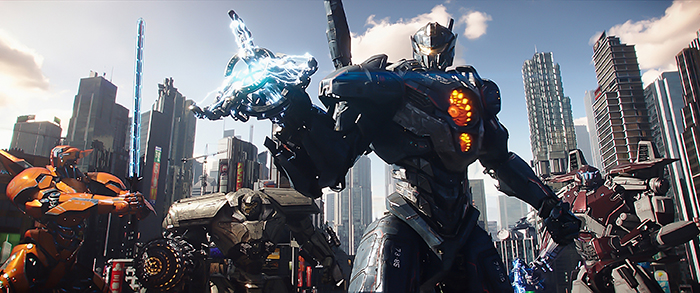 Jaeger mechs Saber Athena, Bracer Phoenix, Gipsy Avenger and Guardian Bravo. Photo courtesy of Legendary Pictures/Universal Pictures. © 2018 Universal Studios. ALL RIGHTS RESERVED.
Jaeger mechs Saber Athena, Bracer Phoenix, Gipsy Avenger and Guardian Bravo. Photo courtesy of Legendary Pictures/Universal Pictures. © 2018 Universal Studios. ALL RIGHTS RESERVED.? Brave New World: Designing in the Light A film in which giant robots fight giant monsters requires a scope and scale that is extraordinary, but the first step was to determine how PACIFIC RIM UPRISING would differ visually from the first film. DeKnight and the producers agreed that the effects in PACIFIC RIM were spectacular, but that they wanted to take the second film in a boldly different direction. Stefan Dechant was engaged as the film’s production designer. Coming from an art director and illustration background, Dechant’s role broadened into taking charge -- alongside DeKnight and director of photography Dan Mindel -- of the plans for the entire visual world. Dechant recalls: “In my very first conversations with Steven, he expressed that he wanted the film to stand on its own. Despite having its roots in Guillermo del Toro’s first movie, it needed its own vision, its own feeling, and its own tone.” Of the key difference he conceived, DeKnight explains: “In the first movie, most of the attacks happen at night in the rain, and it’s atmospheric. But for PACIFIC RIM UPRISING, we wanted to make the majority of the fights during the day. You get a different feel, you can see the entire city and you can get a good look at the monsters. That made it exponentially more difficult, because we couldn’t hide anything in the daylight, but at the same time we were all very excited about the possibilities.” The movie and its design would also have to reflect a world 10 years beyond the first. “In the first film, humanity is very much on the back foot,” shares Dechant. “In this film, it’s a post-war situation. There is money; the PPDC is putting things together and developing technologies and we wanted to explore what that world could look like. We wanted to have more environments at different times of days, different tones. We also wanted to open up some of the Shatterdome sets and let some light in. We wanted to change the color palette, to open up the scope of the exterior fighting scenes.” For Dechant’s crew, the imprint would be not just in the physical world of the film, but the creatures inhabiting it. The first eight weeks for the art department were spent designing the Jaegers and the Kaiju. An important distinguishing aspect for both was decided early on, to give a structure to the design process that would follow. “The idea for the Kaiju and the Jaegers came from Cale Boyter. He talked about giving each unique Jaeger and Kaiju its own specific attribute that separated it from everything else,” explains Dechant. To accomplish, DeKnight and Dechant had a team of artists in the Industrial Light and Magic art department developing Gipsy Avenger and the other Jaegers, followed by the Kaiju. For the Kaiju, storyboard artist DOUG LEFLER and DeKnight laid out what the attributes for the three major Kaiju would be. In keeping with the “let personality inform the design” approach, Dechant explains: “When you look at Saber Athena, for example, she’s all about speed, swiftness and her swords. With the Kaiju Strike Thorn, we took the name and created a creature that throws out giant thorns. They evolved out of the storytelling, so that our design was folding around the cinema that Steven was creating.” The team would pose questions and possibilities, such as “What would it feel like if the Jaegers were like fighter jets?” “There were times where we got much too slick,” notes Dechant, “but it was a process of getting the images down on paper, reviewing, and adjusting.” The production designer appreciates that he had a like-minded director to bring his visions to life. Dechant adds: “Steven is an exceptional designer in his own right, so we could start communicating back and forth in sketches. It was just a nice process to just be with him in creating these environments and these robots.” With the basics of the visual landscape and the creatures set, DeKnight and Dechant then sat down with the illustrators to tell key moments in the film.
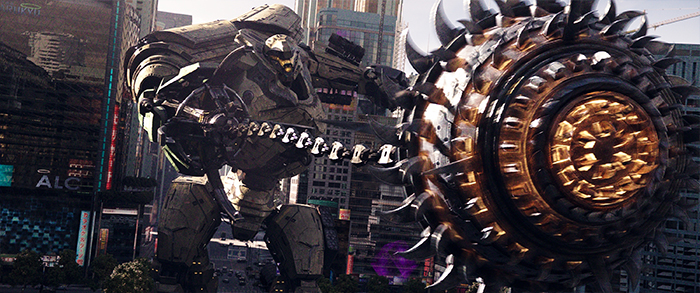 Jaeger mech Bracer Phoenix. Photo courtesy of Universal Pictures. Photo courtesy of Legendary Pictures/Universal Pictures. © 2018 Universal Studios. ALL RIGHTS RESERVED.
Jaeger mech Bracer Phoenix. Photo courtesy of Universal Pictures. Photo courtesy of Legendary Pictures/Universal Pictures. © 2018 Universal Studios. ALL RIGHTS RESERVED.? Practical and CGI: Visual Effects As PACIFIC RIM broke new ground with its VFX, the bar was quite high for this production. Visual effects supervisor PETER CHIANG (STAR TREK: BEYOND, THE BOURNE ULTIMATUM) was called in. Boyter recalls: “We needed a visual effects supervisor who had great instincts and a passion for what we were trying to do. We said to Peter that we didn’t want to do anything that we’d seen before. We showed him where we were, and he said, ‘Give me a few days, I’ll be back with ideas on how to evolve what you’re doing...’” Chiang felt it was crucial to get DP Mindel and PD Dechant’s contributions immediately. Chiang had previously worked with Mindel, and knew that the DP preferred for the camera department to shoot plates. That would allow the VFX team to base their work in reality…an approach that DeKnight was also keen to follow. “I come from a drawing background,” Chiang explains, “so I storyboarded a lot of the visual-effects-heavy sequences, designing a lot of the action beats for Steven, so that his approval or comments on them would lead to the pre-visualization process. A team of three companies -- Halon, Day For Night and The Third Floor -- all did various parts of the pre-visualizations. Then, during the shoot, we captured plates with Dan Mindel and his team, and then finished in postproduction with computer graphics.” Given the scale of the Jaegers and Kaiju, VFX would be a dominant force. “We took over anything that couldn’t be done physically on set,” says Chiang. “In terms of scale, you can hit somebody over the head with a fake bottle provided by the special effects team, but when the script calls for 270-foot tall robots smashing through buildings, crushing cars and fighting giant monsters... that’s when my team needed to come in.” The supervisor admits he saw the opportunity as “a visual effects dream. It involved, first of all, smashing up a lot of buildings, which visual effects people love to do. Added to that, there are other films out there with large monsters, but to have a film that revolves around such massive objects, that’s amazing to work on and realize.” In order to achieve as much realism as possible, DeKnight and Chiang would still use a practical base as a starting point. “Practical effects give us the basis from which to work,” offers Chiang. “They give us clues that we expand from. For example, there’s a sequence with Scrapper, the 40-foot Jaeger. The art department built a small section of the leg, and this gave us fantastic clues as to what the real robot would look like if we could have built the full thing.” During the acquisition process on set, Chiang’s team gathered data about every aspect of the live-shooting strategy -- lenses, camera heights, focal lengths and lighting conditions. A huge team of data wranglers captured photographs and carried out LIDAR scans all over the sets and locations. “A huge volume of data was captured during the live shoot,” says Chiang. “This information was invaluable to us during postproduction. When we place large robots and Kaiju into the scene, it enables us to light them the way that Dan lit them in the plates.” The plates would also be a safeguard. If it were later decided to change a line of dialogue or reshoot an actor, rebuilding a set or returning to a location could be avoided by filming the actor against green or blue screen, then replacing them in the scene. The challenges for Chiang’s team were mostly about scale -- trying to shoot a plate or a location in order to work for the script. “The span of Gipsy Avenger is 70-feet alone, so if it is running down a street, that street needs to be at least five lanes wide in order to accommodate its running gait,” says the VFX supervisor. “Imagining what a 270-foot-tall robot would be like in that space, working out timing when it’s running. There’s always a payoff between moving slowly in order to convey scale, and the desire for fast action; those were huge challenges.” The desire for more daylight also meant not being unable to hide anything under cover of darkness. Chiang notes: “The film takes place in 2035, so we needed to create a slightly futuristic look by adding CG to the present-day plates, which had to blend seamlessly as though it had been physically built. The depth of field, how the sun was in that particular environment, all of that information is key to us seamlessly blending our work into the preexisting plate. It’s harder because it’s daylight, but it was a great challenge and gives a great look.” The VFX team comprised different companies in varying time zones, working at different speeds, with a total of 2,000 members. Chiang had to ensure that each was working seamlessly with colleagues, integrating with DeKnight’s vision and with the other departments. “I was constantly dancing between various roles to make sure that all the trains kept moving forward. The most fascinating thing about the film business is that it combines the personal experiences of everyone working on it together to achieve that one goal. A two-hour film is time-stamped with the efforts of those people coming together, working together toward a unified vision. ” ? Super Tankers in the City: Cameras and Construction • Camerawork DP Mindel was brought in during the concept art and pre-visualization process, while the script was finessed, to refine the world in intensive discussions with DeKnight, Dechant and Chiang. Mindel’s focus was on integration. He explains: “I wanted to keep everything smooth so that the viewer doesn’t get bumped by choices, so they don’t wonder ‘Why did they do that?’ I tried to give the people in the theater no excuse to look at us for taking them out of the story.” As it was for Dechant and Chiang, scale was a massive challenge for Mindel’s entire department. “During the shoot, we had to take a lot of our blue-screen work out into the open air,” says the cinematographer. “We built our own arena to shoot in because we needed the square footage and distance. We could only get the perspective we needed by setting ourselves further away from the blue screen than we could on the biggest stage at Fox Studios Australia.” Mindel began working intimately with Chiang’s and Dechant’s teams, as well as with costume designer Lizz Wolf’s crew, early in the process. “I put a member of the lighting department into the art department early on so that we could get constant feedback about what they were creating. This allowed us to build our lighting into the sets without causing a road block,” Mindel explains. “It’s a very important part of the process. The same thing goes with the wardrobe department; we like to see their color and texture choices early on that so that we’re not taken by surprise.” For the DP, there was a lot of CG work that he calls “imagination-based,” rather than based on logic. “For a lateral thinker, it’s hard to wrap your head around giant robots in a physical space. You have to think, ‘Okay, this thing is the size of a super tanker and it’s walking down the street. What would be happening to the environment, to the dust? What would be the after-effects of something like that walking through a city?’” • Constructing the Sets Dechant was mindful that every set his team created, every color they chose, needed to support the overall visual design of the film as well as the camera and costume departments. “There was a constant communication between the art, camera and costume departments as we crafted this world,” the PD explains. “Dan, Lizz and I would pose questions to each other like ‘How are we setting Liwen apart from the backgrounds? What’s the world of Newt like?’ Lizz and I made sure that the new PPDC uniform and sets integrated meticulously, and one of the great things about Dan is that he would come in and make that set better than I delivered it.” In creating sets, Dechant first asks himself if they are fulfilling the storytelling. “The next is ‘Am I being supportive to the cinematographer, and does he or she have everything they need to tell the story?’ The final question is ‘Does this service the working crew and the cast?’ I want to make sure that we have a set that’s easy to get in, easy to work with, and is inspirational to the actors. I want to make sure they have a space that they can feel is real so that they can be in the moment with Steven and create his story.” For Spaeny, this was successfully achieved: “When we’d walk onto the physical sets, they were so intricate that we were put into that world automatically. There was a lot of imagining that the actors didn’t have to do, because it was all right there.” DeKnight wanted objects like laptops and tablets to be recognizable, but challenged the art department to think about what these items could look like and how they could function 20 years into the future. Property master STEVE MELTON reveals the logic: “You date a movie by electronics. The minute you see a phone or a tablet, you know the year you’re in. Steven would say ‘Let’s recognize what it is, but push it a little. What can we do with the tablets to make them different?’ So, we created a folding technology. The PPDC and Liwen and her team can fold their tablets and put them in their pockets. That was a fun way to advance the vision that I hadn’t seen that in a film before.” For Melton, the approach to weapons was to first recognize that they haven’t changed a lot over the past two centuries. “From the late 1800s to now, they’re similar in terms of how they look and function. What makes a gun futuristic today? Is it that they’re battery operated, or that they can be fired using a fingerprint? Those are things that are cutting-edge today. Steven wanted to recognize that it’s a gun, so we kept them gritty -- a futuristic weapon can look like a toy. For example, we layered them with metals and added a charging light. We gave the weapons a different look, but they’re not so outlandish that it takes you out of the film.” For Dechant, the whole production process and how the sets were constructed within it was like improvising as part of a jazz band. “Steven can have an idea, and say to me ‘It kind of goes like this...’ and I can take that, add my element, bring in Dan and Lizz, and then Steven comes back. It’s the visual equivalent of working with Miles Davis and John Coltrane. You’re not laying down something that they’re going to play, but you’re going to collaborate with these people, and what comes out of it is going to be better than you originally thought.”
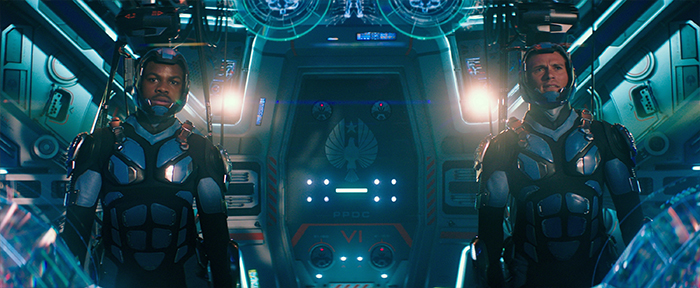 JOHN BOYEGA as Jake and SCOTT EASTWOOD as Lambert in the Gipsy Avenger Conn-Pod. Photo courtesy of Legendary Pictures/ Universal Pictures. © 2018 Universal Studios. ALL RIGHTS RESERVED.
JOHN BOYEGA as Jake and SCOTT EASTWOOD as Lambert in the Gipsy Avenger Conn-Pod. Photo courtesy of Legendary Pictures/ Universal Pictures. © 2018 Universal Studios. ALL RIGHTS RESERVED.? Drive Suits: Dressing Like a Superhero The drive suits worn by Jake, Lambert and the Cadets in piloting the Jaegers were made by Legacy, a company specializing in crafting film super hero suits (SUICIDE SQUAD, CAPTAIN AMERICA: CIVIL WAR, X-MEN APOCALYPSE). Each actor had a precise 360-degree full scan of his or her body created, as the suits would be custom made to their exact forms. “The drive suits were epic,” raves Boyega. “Legacy did a brilliant job in making sure that they were detailed -- but at the same time flexible and comfortable -- because the Jaeger pilots are basically doing acrobatics and ballet inside of the Conn-Pod. It’s great to wear a suit that looks incredible, but at the same time is efficient.”
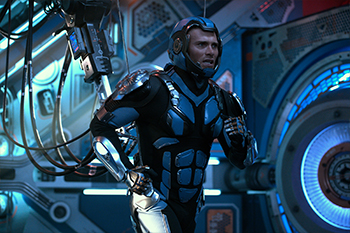 Photo courtesy of Universal Pictures. Photo courtesy of Legendary Pictures/ Universal Pictures. © 2018 Universal Studios. ALL RIGHTS RESERVED.
Photo courtesy of Universal Pictures. Photo courtesy of Legendary Pictures/ Universal Pictures. © 2018 Universal Studios. ALL RIGHTS RESERVED.Given the custom and tight form, the actors had to be vigilant. Spaeny laughs: “It took three people to get me inside that suit. No cheating on meals, because it was going to show everything. We also had to plan our bathroom breaks! It sounds glamorous, but it was actually the total opposite.” For the Cadets, the physicality of the suits played a crucial part in being able to convincingly play the scenes. Meaden notes: “When I first put the drive suit on, everything fell into place. I knew how I was supposed to move, how I was supposed to look, what was supposed to happen. The coordination of the movements was complex, but there was no doubt that standing there, chin up and out... you feel like the hero that the world needs.” Brar adds: “It gave you that adrenaline shot of ‘We’re going to war.’ The five minutes that it took to get onto that suit, having three people help you into it, helped you ease into a mindset of ‘This is really happening. This is real.’” Adams had his own particular take on the matter: “I’d played a superhero in video games as a kid, but at a distance. Now I was in the suit, fighting monsters, and that helped the acting because it’s working from the outside in. Outside forces were affecting what was going on inside of me, and the suit made all the difference. It was very tight and I could feel the protective plates on my chest and arms, and it was just like boyhood dreams made real.” ? Physical Training: Preparing For Battle Getting the cast into peak shape would be essential as their characters came to battle the Kaiju. Throughout pre-production and production, Australian trainer and fitness expert NAOMI TURVEY was tasked with creating rigorous, differentiated regimens for Boyega, Spaeny, Eastwood and the actors playing the Cadets. She worked on building their lean muscle mass and keeping body fat low -- a combination of cardio work interspersed with explosive interval training, and strict diets. Turvey says of her young wards: “They did such a great job. They were diligent with their training six days a week, focusing on the little things as well, like plenty of fluids and good sleep. They were training so hard, as a sports massage therapist I was able to finish our training work with massage recovery so they were staying as pain-free as possible. We achieved great results; I was proud of them and they looked fantastic.” Many scenes were action-specific, requiring complex choreography. “Within each individual’s training program, we incorporated those movements so that they were becoming conditioned to implement them,” Turvey continues. “With John and Scott, we were doing a lot of treadmill work, as well as boxing training, so they would be able sustain through the number of takes.” Of the brutal scenes, Boyega says: “This was the most action I’ve ever done in a movie. It was intense. You don’t want to sound out of breath, and Scott and I had a few scenes where we’re in full-blown dialogue while running, so the training played an important part. I felt goosebumps and rushes of adrenaline at first. But when I’d complete a stunt that worked well, when everybody was in sync and we got what we wanted out of the scene, it felt great.” Spaeny commenced a three-month regimen of parkour, running, boxing, and following a nutrition guide, before heading to Australia to continue training with Turvey. She was challenged and motivated by the action scenes and stunt work, and despite fears and hesitations, stepped up to give everything she had to the role. “Sometimes a stunt would be called for that required climbing up on a part of the set the size of a building, jumping off and rolling out of it, and I would be terrified. The stunt team would ask ‘Are you afraid of heights?’ and I’d say ‘Yes!’ They’d offer for my stunt double to do it, but I’d say ‘No, I have to do it. I have to,’ and it was a fun challenge.”
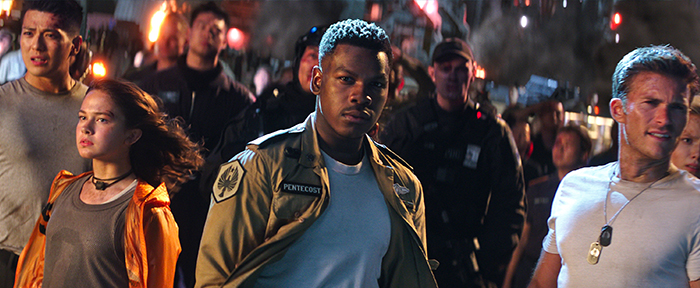 (L to R, foreground) CAILEE SPAENY as Amara, JOHN BOYEGA as Jake and SCOTT EASTWOOD as Lambert. Photo courtesy of Legendary Pictures/Universal Pictures. © 2018 Universal Studios. ALL RIGHTS RESERVED.
(L to R, foreground) CAILEE SPAENY as Amara, JOHN BOYEGA as Jake and SCOTT EASTWOOD as Lambert. Photo courtesy of Legendary Pictures/Universal Pictures. © 2018 Universal Studios. ALL RIGHTS RESERVED.ABOUT THE CAST ? JOHN BOYEGA (Jake Pentecost/Produced by), recipient of the British Academy of Film and Television Arts’ 2016 Rising Star Award and the Chopard Trophy at Cannes, captured worldwide attention for his starring role in STAR WARS: THE FORCE AWAKENS, released by Disney/Lucasfilm in December 2015. Directed by J.J. Abrams, the film grossed over $2 billion worldwide, shattering box-office records and stamping its place in history as the highest-grossing U.S. film release of all time and third-highest internationally. He reprised the role of Finn in STAR WARS: THE LAST JEDI, directed by Rian Johnson in December 2017.
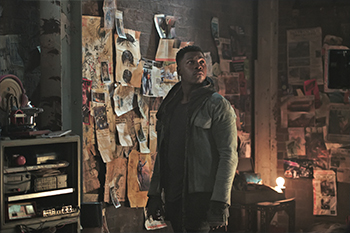 Photo courtesy of Legendary Pictures/Universal Pictures. © 2018 Universal Studios. ALL RIGHTS RESERVED.
Photo courtesy of Legendary Pictures/Universal Pictures. © 2018 Universal Studios. ALL RIGHTS RESERVED.In 2017, Boyega starred in director Kathryn Bigelow’s DETROIT, which was released by Annapurna Pictures. Written by Mark Boal (THE HURT LOCKER, ZERO DARK THIRTY), the true story followed the civil unrest and riots that descended on Detroit for five days during summer 1967. In 2014, he starred in the Netflix feature IMPERIAL DREAMS, which won the Audience Award at the 2014 Sundance Film Festival; and the in 2017, he starred in James Ponsoldt’s adaptation of Dave Eggers’ book The Circle opposite Tom Hanks and Emma Watson. In theater, Boyega starred in the London West End production of "Woyzeck" at The Old Vic Theatre. He trained at the Identity School of Acting before booking his first roles on stage in "Six Parties", directed by Emma Keele at The National Theatre, and "Category B" at The Tricycle Theatre, directed by Paulette Randall. Additional theater credits include "Seize the Day" (Tricycle Theatre) and "Detaining Justice" (Tricycle Theatre). Boyega first garnered industry attention in Joe Cornish’s cult sci-fi film ATTACK THE BLOCK, which won the Audience Award at SXSW in 2011 among other accolades that year. He went on to star in HALF OF A YELLOW SUN alongside Chiwetel Ejiofor; the HBO pilot DA BRICK, directed by Spike Lee; the BBC film MY MURDER, directed by Bruce Goodison; and the BBC/Discovery feature length drama THE WHALE, alongside Martin Sheen. His television credits include the critically acclaimed BBC series BECOMING HUMAN, LAW & ORDER: UK for ITV and 24: LIVE ANOTHER DAY. He currently resides in London. ? SCOTT EASTWOOD (Nate Lambert) is quickly emerging as one of Hollywood’s most highly sought-after actors. Eastwood was most recently seen in the eighth installment of the FAST AND FURIOUS franchise titled THE FATE OF THE FURIOUS. Directed by F. Gary Gray, Eastwood joined co-stars Vin Diesel, Dwayne Johnson and Charlize Theron for the film, which broke global box-office records.
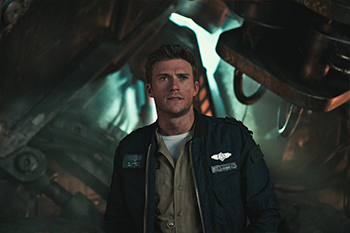 Photo courtesy of Legendary Pictures/Universal Pictures. © 2018 Universal Studios. ALL RIGHTS RESERVED.
Photo courtesy of Legendary Pictures/Universal Pictures. © 2018 Universal Studios. ALL RIGHTS RESERVED.His most recent projects include David Ayer’s DC Comics film SUICIDE SQUAD, alongside Will Smith and Jared Leto; and Oliver Stone’s biographical drama SNOWDEN (Open Road Films), in which he starred alongside Shailene Woodley, Joseph Gordon-Levitt and Zachary Quinto. In 2015, Eastwood co-starred alongside Britt Robertson as champion bull rider Luke Collins in the romantic drama THE LONGEST RIDE, based on the novel by Nicholas Sparks. He also appeared opposite Brad Pitt and Shia LaBeouf in the war drama Fury for Ayer. His other film credits include GRAN TORINO, DAWN PATROL, INVICTUS and FLAGS OF OUR FATHERS. Aside from his various films, Eastwood can also be seen in Taylor Swift’s music video “Wildest Dreams” in which he stars as her love interest. The video was released in August 2015 and received over 10 million views in its opening weekend. Eastwood is the face of the 2017 BMW 5 Series campaign, Davidoff Cool Water cologne, Persol sunglasses and IWC Schaffhausen watches. ? JING TIAN (Liwen Shao) has emerged as one of the most exciting young actresses in the international film community and is poised to make her mark in the U.S. In 2017, Tian made her American film debut in Universal Pictures’ THE GREAT WALL. In the film, Tian played the role of Chinese General Lin Mei, opposite Matt Damon and his band of European mercenaries. That same year, she joined Samuel L. Jackson, Brie Larson and Tom Hiddleston in Warner Bros’ KONG: SKULL ISLAND. Over the past two years, Tian has emerged as one of China’s leading actresses in both film and television. Holding her own with Chinese film legends, Tian has built a reputation as one of the most dynamic women in the industry. Often using her extensive physical dance training as an asset, Tian has taken on every role with intense training, as she often prefers to perform her own stunts. In July 2017, FIST & FAITH (Qinghenangao) opened in theaters in the Chinese domestic market. In the story, set in Manzhouli during the period of Japanese rule, Tian played a patriotic teacher who enlightens the students to act following their hearts. In 2013-2014, Tian starred in three blockbuster films: SPECIAL ID with Donnie Yen, POLICE STORY: LOCKDOWN with the legendary Jackie Chan and THE MAN FROM MACAO with another Chinese legend, Chow Yun-Dat. These three films grossed more than $1.3 billion at the Chinese box office. Her strong performances in these films led her to the 18th Annual Hollywood Film Awards, where Tian won the inaugural Hollywood International Award.
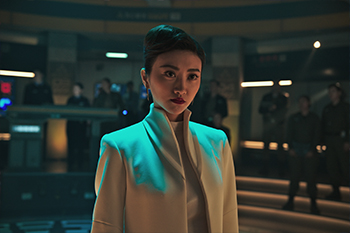 Photo courtesy of Legendary Pictures/Universal Pictures. © 2018 Universal Studios. ALL RIGHTS RESERVED.
Photo courtesy of Legendary Pictures/Universal Pictures. © 2018 Universal Studios. ALL RIGHTS RESERVED.Complementing her big-screen success, Tian has also portrayed widely beloved characters on Chinese television. In early 2014, she starred in Yu Zheng’s LEGEND OF BAN SHU, a historical drama set during the Han dynasty. She played the titular character, a beautiful young teacher at the Imperial Palace kindergarten, who captures the attention and heart of the Emperor. Tian also recently starred in the eponymous role of the television series THE LEGEND OF XIAO ZHUANG. Tian attracted widespread attention with her 2010 movie debut MY BELLE BOSS (Wo de meinu laoban), in which the 22-year-old played two conflicting roles. Over the next two years, she took on challenging roles in a series of large historical costume dramas, such as THE WARRING STATES (Zhan Guo), BETTER AND BETTER (Yue Lai Yue Hao) and TEARS IN HEAVEN. Tian grew up in Xi’an, Shaanxi province (also director Zhang Yimou’s birthplace), a city with 7,000 years of history, where the vast armies of Terracotta Warriors were discovered dating from the Qin dynasty and the first emperor of China. She left home at age 13 to begin extensive training at the Secondary School of Beijing Dance Academy. Her love of dancing soon flourished into a passion for acting and, upon graduation, she went on to complete her education at the Beijing Film Academy. Off-screen, Tian also devotes a great deal of her time towards humanitarian efforts supporting missions to earthquake-stricken areas, as well as aiding disadvantaged children. ? Newcomer CAILEE SPAENY (Amara Namani) is a star on the rise. Hailing from a small town in Missouri, Spaeny won the role of Amara in a nationwide search at the age of 18. She has since landed roles in the Ruth Bader Ginsburg biopic ON THE BASIS OF SEX, alongside Felicity Jones and Armie Hammer; BAD TIMES AT THE EL ROYALE, opposite Jeff Bridges and Russell Crowe; and Adam McKay’s Dick Cheney biopic BACKSEAT, which stars Christian Bale. ? RINKO KIKUCHI (Mako Mori) has shown range and depth with every role she plays. Kikuchi landed her first professional role in the Japanese film IKITAI (Will to Live) in 1999. Since then she displayed her talent as an actress starring in critically acclaimed Japanese films such as HOLE IN THE SKY (2001) and THE TASTE OF TEA (2004) and gained popularity within Japan’s film industry. It wasn’t long before she catapulted onto the international scene with her Academy Award-nominated role for Best Supporting Actress in Alejandro González Iñárritu’s BABEL (2006). Playing the role of the young, deaf, high school girl Chieko with fervent energy and commitment, Kikuchi achieved an outstanding reputation around the world for her dramatic performance and the film garnered seven Academy Award nominations, securing her status as one of Hollywood’s leading young actresses. Kikuchi followed up her success with a number of highly acclaimed international films including Rian Johnson’s THE BROTHERS BLOOM (2008) with Adrien Brody and Rachel Weisz; Isabel Coixet’s MAP OF THE SOUNDS OF TOKYO (2009) with Sergi López; Mikael Håfström’s SHANGHAI (2010) with John Cusack and Ken Watanabe; Tran Anh Hung’s NORWEGIAN WOOD (2010), a highly anticipated adaptation of Haruki Murakami’s international best-selling novel of the same name; and Carl Rinsch’s 47 RONIN (2013) with Keanu Reeves. In 2015, she was nominated for Best Female Lead for KUMIKO, THE TREASURE HUNTER (2014) at the Film Independent Spirit Awards. Kikuchi hails from Hadano, Japan, and is a skilled swordfighter as well as an accomplished motorcyclist and horseback rider. She was named one of the “10 Actors to Watch” by Variety in 2007. ? BURN GORMAN (Dr. Hermann Gottlieb), continuing to be one of Hollywood’s most interesting actors, was recently seen in season four of the AMC series TURN: WASHINGTON`S SPIES, starring as Major Hewlett.
 Photo courtesy of Legendary Pictures/Universal Pictures. © 2018 Universal Studios. ALL RIGHTS RESERVED.
Photo courtesy of Legendary Pictures/Universal Pictures. © 2018 Universal Studios. ALL RIGHTS RESERVED.Gorman is best known for his performances in Christopher Nolan’s THE DARK KNIGHT RISES, Guillermo del Toro’s PACIFIC RIM, BBC’s BLEAK HOUSWE and as Dr. Owen Harper in TORCHWOOD. Born in the U.S. and raised in the U.K., Gorman is well known in theater, film and television as an extremely versatile character actor. He has appeared in numerous British Academy of Film and Television Arts and Primetime Emmy Award-winning productions. Recent television includes miniseries AND THEN THERE WERE NONE for BBC/A&E, THE MAN IN THE HIGH CASTLE for Amazon, FOREVER for ABC, IT’S ALWAYS SUNNY IN PHILADELPHIA for FX, HBO’s GAME OF THRONES and Stan Lee’s LUCKY MAN for Sky One. Gorman’s recent films include GUERNIKA; IMPERIUM; CRIMSON PEAK; IN A VALLEY OF VIOLENCE; and ALEXANDER AND THE TERRIBLE, HORRIBLE, NO GOOD, VERY BAD DAY. ? ADRIA ARJONA (Jules Reyes) is quickly becoming a household name. Arjona most recently starred as Dorothy Gale on NBC’s epic new fantasy drama series EMERALD CITY. The show is an edgy interpretation of L. Frank Baum’s Oz book series, following the iconic character transported from Kansas to the Land of Oz by a tornado, and her journey to find The Wizard, played by Vincent D’Onofrio. Arjona can be seen in the James Gunn-penned MGM feature film THE BELKO EXPERIMENT, which also starred John Gallagher, Jr. and Tony Goldwyn. She can next be seen in Warner Bros.’ LIFE OF THE PARTY, set for release in May 2018. Arjona plays sorority sister Amanda in the Melissa McCarthy comedy with an ensemble including Julie Bowen, Gillian Jacobs, Debby Ryan, Maya Rudolph and Chris Parnell. Previous television credits include guest-starring roles on CBS’s UNFORGETTABLE and PERSON OF INTEREST, as well as Netflix’s NARCOS. She gained further recognition in her role as Emily on HBO’s TRUE DETECTIVE, opposite Vince Vaughn, Colin Farrell, Rachel McAdams and Taylor Kitsch. Arjona was born in Puerto Rico and raised in Mexico City. She currently resides in Los Angeles. ? CHARLIE DAY’s (Dr. Newton Geiszler) comedic talent in both film and television has garnered him a loyal following among critics and fans all over the world. Day currently stars as the hapless Charlie Kelly on IT’S ALWAYS SUNNY IN PHILADELPHIA for which he also writes and executive produces. He created the show in collaboration with friends and co-producers Rob McElhenney and Glenn Howerton. The series will return for its 13th season this year on FXX. Before IT’S ALWAYS SUNNY IN PHILADELPHIA, Day had a recurring role on NBC’s THIRD WATCH and also appeared on the Fox comedy LUIS. Other television credits include DRUNK HISTORY, LAW & ORDER, AMERICAN DAD!, RENO 911!, MARY AND RHODA, MADIGAN MEN, CAMPFIRE STORIES and UNSUPERVISED. In film, Day is best known for his roles in GOING THE DISTANCE, HORRIBLE BOSSES, MONSTERS UNIVERSITY, PACIFIC RIM, THE LEGO MOVIE, HORRIBLE BOSSES 2, VACATION, THE HOLLARS and FIST FIGHT. In 2015, Day was nominated for a MTV Movie Award for his role in HORRIBLE BOSSES 2. Day began his acting career onstage and participated in the Williamstown Theatre Festival for four years. He went on to play the lead role in "Dead End" at the Huntington Theatre in Boston. Day was born in the Bronx, New York, and grew up in Rhode Island. He currently lives in Los Angeles with his wife, Mary Elizabeth Ellis, and their son.
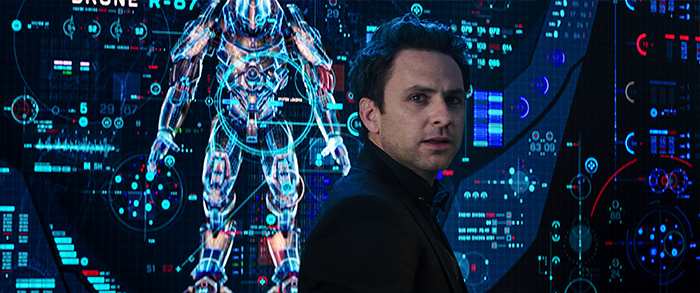 Photo courtesy of Legendary Pictures/Universal Pictures. © 2018 Universal Studios. ALL RIGHTS RESERVED.
Photo courtesy of Legendary Pictures/Universal Pictures. © 2018 Universal Studios. ALL RIGHTS RESERVED.ABOUT THE FILMMAKERS ? STEVEN S. DEKNIGHT (Directed by/Written by) attended the University of California, Santa Cruz where he graduated with a bachelor’s degree in theater arts and went on to earn an MFA in playwriting from UCLA.
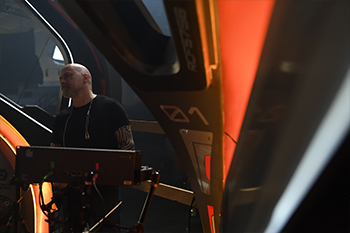 Photo courtesy of Legendary Pictures/Universal Pictures. © 2018 Universal Studios. ALL RIGHTS RESERVED.
Photo courtesy of Legendary Pictures/Universal Pictures. © 2018 Universal Studios. ALL RIGHTS RESERVED.He has written for the groundbreaking Joss Whedon series BUFFY THE VAMPIRE SLAYER and wrote, directed and produced on the series ANGEL, SMALLVILLE and DOLLHOUSE before creating and running the SPARTACUS series for the premium cable channel Starz. Most recently, he was the executive producer/showrunner for the first season of the Marvel/Netflix series DAREDEVIL. ? EMILY CARMICHAEL (Written by) is a writer and director of science fiction, fantasy and action movies. Her short films have screened at Sundance, Slamdance, SXSW, Tribeca and top festivals all around the world. Her recent writing work includes Disney’s reboot of the 1979 sci-fi film THE BLACK HOLE. She is currently attached to direct POWERHOUSE with producers Steven Spielberg, Colin Trevorrow and Simon Kinberg, as well as her own science fiction film EON. ? KIRA SNYDER (Written by) is a Primetime Emmy Award and Golden Globe Award winner for her work on THE HANDMAID’S TALE for Hulu/MGM/Littlefield Co., where she is a writer and currently the co-executive producer. Previously, she was the supervising producer on the CW’s THE 100, where she has worked on three seasons of the hit Warner Bros. series. Snyder has also staffed on Starz’s INCURSION for Steven S. DeKnight, as well as SyFy’s ALPHAS and EUREKA. She got her start working on CBS’s MOONLIGHT after graduating from the prestigious Warner Bros. Television Writers’ Workshop. She has a background in theater and videogame writing, having worked at Electronic Arts. Her YA mystery book series Parish Mail is available through publisher Coliloquy. She was a graduate of the prestigious WGA Showrunner Training Program. ? T.S. NOWLIN (Written by) is the architect behind Fox’s MAZE RUNNER trilogy. He co-wrote the first film, and went on to write both the sequel THE SCORCH TRIALS, and the third installment THE DEATH CURE, which was released in January 2018. Nowlin’s script OUR NAME IS ADAM is set up at Paramount with David Yates directing and Mary Parent producing. ? TRAVIS BEACHAM’s (Based on the Characters Created by) extensive work includes CLASH OF THE TITANS, PACIFIC RIM, Amazon’s anthology series PHILIP K. DICK’S ELECTRIC DREAMS and the upcoming fantasy-thriller series CARNIVAL ROW. He wrote and directed his own original science fiction short THE CURIOSITY in 2016 and is currently at work on its adaptation into a digital series. He is also working on an original podcast series. He is a graduate of the North Carolina School of the Arts and is from Tennessee. ? MARY PARENT, p.g.a. (Produced by) is the vice chairman of worldwide production at Legendary Entertainment overseeing all aspects of film, television, digital, mobile and new media. Prior to joining Legendary in 2016, Parent was founder and CEO of Disruption Entertainment, where she produced a prolific slate of films including THE REVENANT, which Parent received an Oscar-nomination for Best Picture and won both a Golden Globe Award and a BAFTA Award for Best Film. She also produced KONG: SKULL ISLAND, THE SPONGEBOB MOVIE: SPONGE OUT OF WATER, GODZILLA, NOAH, and PACIFIC RIM, which were all commercial and critical successes. Most recently, Parent produced Alejandro G. Iñárritu’s virtual reality piece CARNE Y ARENA, which received a rare Special Achievement Oscar from the Academy of Motion Picture Arts and Sciences for its groundbreaking exploration into fully-immersive storytelling. Prior, Parent served as vice chairman of worldwide production at Universal Pictures and chairman of MGM. As an executive or producer, Parent has actively been involved in films amassing over $20 billion at the global box office. Legendary is currently in production on DETECTIVE PIKACHU, starring Ryan Reynolds, Bill Nighy, Justice Smith, Kathryn Newton and Rita Ora. The company is also in postproduction on the next epic in Legendary’s MonsterVerse franchise, GODZILLA: KING OF THE MONSTERS, starring Kyle Chandler, Vera Farmiga, Millie Bobby Brown and Ken Watanabe as well as SKYSCRAPER starring Dwayne Johnson and Neve Campbell. Parent is a producer on all three films. ? CALE BOYTER, p.g.a. (Produced by) began his career at New Line Cinema, where he worked for 10 years and was behind hits such as ELF, WEDDING CRASHERS, JUST FRIENDS and A HISTORY OF VIOLENCE. He joined Mary Parent at Disruption Entertainment, her production company with a first-look deal at Paramount Pictures, where his credits included NOAH and THE SPONGEBOB MOVIE. Now at Legendary, next in line for Boyter are the highly anticipated films SKYSCRAPER, starring Dwayne Johnson, and the first live-action Pokémon movie, starring Ryan Reynolds. ? GUILLERMO DEL TORO (Produced by) is among the most creative and visionary artists of his generation, whose distinctive style is showcased through his work as a filmmaker, screenwriter, producer and author. Born in Guadalajara, Mexico, del Toro first gained worldwide recognition for the 1993 Mexican-American co-production CRONOS, a supernatural horror film, which he directed from his own screenplay, after beginning his career working as a special effects makeup artist. The film premiered at the 1993 Cannes Film Festival, where it won the Mercedes-Benz Award. It also won more than 20 international awards, including eight Ariel Awards from the Mexican Academy of Film, including Best Director, Best Screenplay and the Golden Ariel. His subsequent films include MIMIC, THE DEVIL’S BACKBONE, HELLBOY, PAN’S LABYRINTH, HELLBOY II: THE GOLDEN ARMY, PACIFIC RIM and CRIMSON PEAK. Del Toro earned international acclaim as the director, writer and producer of the 2006 fantasy drama PAN’S LABYRINTH. He was honored with an Oscar® nomination for his original screenplay for the film, which received five additional Oscar nominations, including Best Foreign Language Film, and won for Art Direction, Cinematography and Makeup. In all, the film garnered more than 40 international awards and appeared on more than 35 critics’ lists of the year’s best films. Del Toro’s contemporary fairy tale THE SHAPE OF WATER was released in December 2017 for Fox Searchlight, to great acclaim. Del Toro was honored with the Golden Globe Award for best director for his work on the film, and the film was nominated for 13 Academy Awards, winning best picture, best director, best production eesign, and best original score. Through his overall deal with DreamWorks Animation, del Toro has been an executive producer on the films KUNG FU PANDA 2, KUNG FU PANDA 3, PUSS IN BOOTS, PUSS IN BOOTS 2: NINE LIVES & 40 THIEVES and RISE OF THE GUARDIANS. He produced THE BOOK OF LIFE for Fox Animation and Reel FX. His DreamWorks animated series TROLLHUNTERS recently debuted on Netflix to great critical and audience acclaim. With novelist Chuck Hogan, he co-authored the vampire-horror novel The Strain, which was published in June 2009 by William Morrow. They have since collaborated on The Fall and The Night Eternal, which make up The Strain Trilogy. All three books debuted as The New York Times top-10 best sellers. Del Toro is currently developing a series based on Naoki Urasawa’s acclaimed manga series Monster for Sony Television and Showtime Networks. In 2013, Harper Design published Guillermo del Toro Cabinet of Curiosities: My Notebooks, Collections, and Other Obsessions, a lavishly illustrated book containing notes, drawings and untold creatures from del Toro’s private journals and filmmaking diaries, with never-before-seen characters, art and ideas of things to come. From this book, it was a natural progression to the unique art museum exhibition, "Guillermo del Toro: At Home with Monsters", which was on display at the Los Angeles County Museum of Art from September 30, 2017 to January 7, 2018. The widely acclaimed exhibition, which explored the sources of del Toro’s creativity and features artwork from his collections, selections from the museum’s holdings and del Toro’s personal notebooks, will travel next to co-sponsoring museum, Minneapolis Institute of Art and Toronto’s Art Gallery of Ontario. ? FEMI OGUNS (Produced by) MBE is a leading British agent, producer and founder of the Identity Agency Group and Identity School of Acting. Oguns founded Identity School of Acting in October 2003. After leaving drama school, he went on to university where he obtained a joint honors degree in Race, Culture and Performing Arts. It was there he drew on personal experience and longed to create a drama school which would give actors of all ethnicities the platform to express themselves to their fullest. Oguns’ considerable achievements have led to a series of high-profile commendations. In 2010, he was named as a U.K. Film Council Breakthrough Brit in the fields of acting and writing. He was also named on Powerful Media’s Power List of the top 100 most influential figures of African/Caribbean descent. In 2014, he was appointed Member of the Order of the British Empire (MBE) by Queen Elizabeth II for his services to the acting industry. As an actor, Oguns has featured in a number of award-winning dramas in both television and film. Oguns has also carved out a successful career in the field of writing, where his debut play "Torn" received the MSVA Award for Best Stage Production in 2008. The immense success of "Torn" caught the attention of the Royal National Theatre and The Royal Court, where he developed his second play, "Sponge". Founded in 2006, Identity Agency Group (IAG) is now one of the United Kingdom’s leading acting agencies; Oguns is the CEO and lead agent. IAG is the first point of call for casting directors seeking the very best in diverse talent. In 2011, IAG U.S. division was formed, merging with some of the top agencies and management companies in the U.S., representing clients both in the U.K. and North America. IAG Los Angeles is now working in partnership with the likes of WME, Gersh and ICM, to name a few. Alongside his client of nine years, John Boyega, Oguns co-founded production company Upperroom Entertainment LTD in 2016. ? THOMAS TULL (Produced by) is the founder, chairman and CEO of Tulco. Tull previously served as founder, chairman and CEO of Legendary Entertainment, a leading media company with film, television, and digital and publishing divisions. Under Tull, Legendary’s associated productions realized grosses of more than $13 billion worldwide. In January 2016, the company was acquired by the Dalian Wanda Group Co., Ltd. Tull also chairs Tull Investment Group which provides capital for early to mid-stage companies and has provided early funding to Magic Leap, Pinterest, Zoox, Heal, Blend Systems, The Cipher Brief and Oculus Rift, the latter which resulted in a lucrative exit to Facebook. During his career, Tull has produced and executive produced more than 40 films including STRAIGHT OUTTA COMPTON and the world-record-breaking JURASSIC WORLD. Other past credits include WARCRAFT, KRAMPUS, CRIMSON PEAK, GODZILLA, PACIFIC RIM, 42, BATMAN BEGINS, THE DARK KNIGHT, THE DARK KNIGHT RISES, 300 and its sequel 300: RISE OF AN EMPIRE, the critically and commercially received THE TOWN, the award-winning action-drama INCEPTION, CLASH OF THE TITANS and its sequel WRATH OF THE TITANS, the HANGOVER franchise and KONG: SKULL ISLAND. Tull also serves on the Board of Directors of Hamilton College, his alma mater, and Carnegie Mellon University. He also sits on the boards of the National Baseball Hall of Fame and Museum, the National Football Foundation and the Smithsonian Institution. He is an Entrepreneur-in-Residence at Harvard Business School and part of the six-time Super Bowl champion Pittsburgh Steelers ownership group, where he also holds a board seat. ? JON JASHNI (Produced by) is a media investor and content producer who operates through his investment fund Raintree Ventures. Jashni is also a strategic advisor to Morgan Stanley, Evolution Media (a joint venture between TPG Capital and Creative Artists Agency), Bonfire Game Studios, Mass Appeal and Jaunt VR. Previously, Jashni was president and chief creative officer of Legendary Entertainment where, as part of his duties, he oversaw the development and production of such film projects as KONG: SKULL ISLAND, WARCRAFT, KRAMPUS, CRIMSON PEAK, GODZILLA, the Jackie Robinson biopic 42 and PACIFIC RIM. He joined the company in January 2006 and was integrally involved over a 10-year period in evolving the company from a film-financing entity into a diversified, multi-platform media company. Jashni also drove Legendary’s acquisition of the Irwin Allen Estate Library (e.g., LOST IN SPACE, THE TIME TUNNEL, VOYAGE TO THE BOTTOM OF THE SEA, LAND OF THE GIANTS, THE POSEIDON ADVENTURE, THE TOWERING INFERNO) -- an IP studio, which Jashni and his partner, filmmaker Kevin Burns, oversee via their company Synthesis. Netflix has ordered a full season of a reimagined LOST IN SPACE from Synthesis and Legendary Television for Q1 2018 release. Prior to Legendary, Jashni was president of Hyde Park Entertainment, a production and financing company with overall deals at 20th Century Fox, Walt Disney Pictures and MGM. At Hyde Park, he oversaw the development and production of SHOPGIRL, DREAMER: INSPIRED BY A TRUE STORY, WALKING TALL and PREMONITION. Before joining Hyde Park, Jashni was a producer on director Andy Tennant’s hit romantic comedy SWEET HOME ALABAMA. His collaboration with Tennant began with the fairy tale EVER AFTER: A CINDERELLA STORY, for which Jashni oversaw development and production as a senior production executive at 20th Century Fox. Jashni also co-produced two Academy Award-nominated films: the critically acclaimed drama THE HURRICANE, which garnered a Best Actor nomination for star Denzel Washington, and ANNA AND THE KING (a non-musical reinterpretation of Anna and the King of Siam), which starred Jodie Foster and earned two Oscar nominations. Jashni was earlier partnered with industry powerbroker Irving Azoff at the Warner Bros.-based Giant Pictures. In addition to THE HURRICANE, they produced JACK FROST and THE INKWELL. Jashni joined Azoff after a stint as a production executive at Columbia Pictures, where he was involved in the development and production of such films as GROUNDHOG DAYy and BRAM STOKER`S DRACULA. Jashni began his career at Daniel Melnick’s The IndieProd Company, where he was involved in the production of ROXANNE, AIR AMERICA, MOUNTAINS OF THE MOON and PUNCHLINE. Jashni is a member of the Academy of Motion Picture Arts and Sciences and the Producers Guild of America in addition to serving as a trustee of the American Film Institute. He holds a Bachelor of Science from the University of Southern California and a Master of Business Administration from UCLA’s Anderson School of Management. ? ERIC MCLEOD (Executive Producer) is a producer and executive producer with a career spanning over 30 years. His experience amounts to a vast body of work, both in the type of projects he has undertaken and developed, and also his roles within those productions. His films are often complex undertakings, shot in international locations. For the Austin Powers films, he executive produced AUSTIN POWERS: INTERNATIONAL MAN OF MYSTERY (1997) and produced AUSTIN POWERS: THE SPY WHO SHAGGED ME (1999) and AUSTIN POWERS in Goldmember (2002). Further adding his range to another successful franchise, he also served as executive producer on the PIRATES OF THE CARIBBEAN sequels, PIRATES OF THE CARIBBEAN: DEAD MAN`S CHEST (2006) and PIRATES OF THE CARIBBEAN: AT WORLD`S END (2007), both directed by Gore Verbinski. In 2005, McLeod produced MR. & MRS. SMITH, which starred Brad Pitt and Angelina Jolie. In 2008, he produced DreamWorks’ TROPIC THUNDER, directed by Ben Stiller and which starred Stiller, Jack Black and Robert Downey, Jr., which went on to both box-office and awards success. He also produced Tony Scott’s critically acclaimed UNSTOPPABLE in 2010, which starred Denzel Washington and Chris Pine, and was executive producer on THE LONE RANGER in 2013 with Johnny Depp and Armie Hammer. Other credits include BLACKHAT (2015), 47 RONIN (2013), PRINCE OF PERSIA: THE SANDS OF TIME (2010), THE DUKES OF HAZZARD (2005), THE CAT IN THE HAT (2003), SHOWTIME (2002), THE CELL (2000), ENEMY OF THE STATE (1998), LIVING OUT LOUD (1998), WAG THE DOG (1997), FEELING MINNESOTA (1996), NOW AND THEN (1995), CORRINA, CORRINA (1994), EVEN COWGIRLS GET THE BLUES (1993), CRY-BABY (1990) and DRUGSTORE COWBOY (1989). Most recently McLeod was the executive producer on the Legendary Entertainment film KONG: SKULL ISLAND, which starred Brie Larsen, Tom Hiddleston, Samuel L. Jackson, John Goodman and John C. Reilly. ? DAN MINDEL, ASC, BSC (Director of Photography) attended high school in England in the mid-1960s where, on his own initiative, he learned how to photograph and process 35 mm still images. His father had owned an 8 mm film camera, but Mindel was drawn to real motion picture cameras. At college, he saw a newspaper advertisement looking for someone to make tea and clean the floors at London film studio Brooks Fulford Cramer Seresin. Mindel got the job and intently observed all that was going on, with one partner, Michael Seresin, allowing the young man to help the camera assistants. Mindel became a trainee at the studio and eventually gained his union membership. Mindel’s break came when he was invited to work on reshoots of Tony Scott’s film THE HUNGER, and soon began working with both Tony and Ridley Scott as a camera assistant on commercials, travelling back and forth between the U.K. and the U.S. He moved up to focus puller on Tony Scott’s REVENGE, then worked on Ridley Scott’s THELMA & LOUISE, finally shooting commercials, low-budget films and episodic television. Tony Scott invited Mindel to shoot the $100 million film ENEMY OF THE STATE, and from there his career took off. He has been director of photography on such blockbusters as MISSION IMPOSSIBLE III, STAR TREK and STAR TREK: INTO DARKNESS, THE AMAZING SPIDER-MAN 2 and STAR WARS: THE FORCE AWAKENS. ? STEFAN DECHANT (Production Designer) has had a number of notable art director credits including Steven Spielberg’s THE BFG, the Coen brothers’ TRUE GRIT and M. Night Shyamalan’s LADY IN THE WATER. He moved on to production design with Jordan Vogt-Roberts’ KONG: SKULL ISLAND for Legendary/Warner Bros. He just wrapped shooting an untitled Robert Zemeckis project for Universal Pictures, which will be released on November 21, 2018. He lives in Los Angeles with his wife, Christina and his two children, Cole and Emelie. ? ZACH STAENBERG, ACE (Editor) is an Academy Award-winning editor for his work on the groundbreaking THE MATRIX trilogy. He also edited SPEED RACER and BOUND with the Wachowski brothers. Other recent credits include SAND CASTLE, directed by Fernando Coimbra for Netflix, produced by The Mark Gordon Company and Treehouse Pictures; and GOOD KILL, directed by Andrew Niccol, which premiered at the 2014 Venice International Film Festival and the Toronto International Film Festival. Staenberg previously collaborated with Niccol on IN TIME, which starred Justin Timberlake and Amanda Seyfried, and LORD OF WAR, which starred Nicholas Cage. In addition, he edited ENDER`S GAME, the martial-arts action film BUNRAKU and the Academy Award-nominated foreign film MONGOL: THE RISE OF GENGHIS KHAN. In 1996, Staenberg won the first of his two ACE Eddie Awards for his work on the HBO telefilm GOTTI, which also garnered him a Primetime Emmy Award nomination for Outstanding Editing for a Miniseries or a Special - Single Camera Production. LIZZ WOLF (Costume Designer) has worked on the productions of over 30 feature films, spanning a variety of periods, genres and styles, while collaborating with distinguished directors such as Tony Scott, Steven Soderbergh, Michael Bay, Bill Condon, James Mangold and Brian De Palma. The daughter of an interior designer and a textile salesman, Wolf went on to study fashion and costume design at Otis College of Art and Design and The American College in London. Driven by a love of film and character, Wolf embarked on a career in Hollywood where her early credits as an assistant costume designer included ARMAGEDDON, TRAFFIC, THE BLACK DAHLIA and DREAMGIRLS. Her credits as a costumer include PIRATES OF THE CARIBBEAN: THE CURSE OF THE BLACK PEARL, DODGEBALL: A TRUE UNDERDOG STORY, A SINGLE MAN and 3:10 TO YUMA. In addition to her work in film, Wolf has also worked in theater. In 2011, she received an Outer Critics Circle award nomination for her costume design work in the 1960s-set musical "Baby It’s You!" (Universal Music Group, Warner Bros. Theatre Ventures), which had its world premiere at the Pasadena Playhouse before heading to Broadway. Wolf has been the costume designer for all three THE EXPENDABLES films as well as being featured on Shintaro Shimosawa’s MISCONDUCT and Nic Mathieu’s SPECTRAL, both of which were released in 2016. Her most recent project is the Netflix film TRUE MEMOIRS OF AN INTERNATIONAL ASSASSIN. ? LORNE BALFE (Music by) is a Grammy Award-winning, Primetime Emmy- and BAFTA Award-nominated composer from Inverness, Scotland. He has scored in virtually all genres and in all visual media, with projects ranging from major studio to independent films, tentpole video game franchises, animated feature films, critically acclaimed television series and documentary features. Balfe recently received a Primetime Emmy Award nomination for Outstanding Original Main Title Theme (shared with Hans Zimmer) for GENIUS, the Ron Howard-produced television series about Albert Einstein. His recent film credits include the scores for THE FLORIDA PROJECT, THE LEGO BATMAN MOVIE, GHOST IN THE SHELL, CHURCHCHILL and GEOSTORM. His previously composed the scores for such films as 13 HOURS, TERMINATOR GENISYS, GLORIA, IRONCLAD and the animated hits HOME and PENGUINS OF MADAGASCAR. He also created the music for the acclaimed documentaries MANNY, SALINGER and THE LAST MAN ON THE MOON. In addition, Balfe served as the score producer for the 2017 hit DUNKIRKk and, most recently, 12 STRONG, the declassified true story of the horse soldiers. Balfe’s big break came when he scored his first major feature film MEGAMIND, which he co-composed with Hans Zimmer. Within a year, he expanded his scoring talents into video games, composing alongside Jesper Kyd on “Assassin’s Creed: Revelations,” which received a BAFTA Award nomination for Best Original Music. His video game credits now include “Crysis 2”; four titles in the “Skylanders” series (“Spyro’s Adventure,” “Giants,” “The SWAP Force” and “Trap Team”); “Assassin’s Creed III: The Tyranny of King Washington”; “Call of Duty: Modern Warfare 2”; and “Beyond: Two Souls.” His television work includes the epic miniseries THE BIBLE (co-composed with Zimmer) and SONS OF LIBERTY. In 2012, Balfe earned his first Primetime Emmy Award nomination for the miniseries RESTLESS. CREDITS Release Date: March 23, 2018 Genre: 3D Epic Adventure Legendary Pictures and Universal Pictures present a Legendary Pictures/DDY Production Cast: John Boyega, Scott Eastwood, Jing Tian, Cailee Spaeny, Rinko Kikuchi, Burn Gorman, Adria Arjona, Max Zhang and Charlie Day Directed by: Steven S. DeKnight Screenplay by: Emily Carmichael & Kira Snyder and Steven S. DeKnight and T.S. Nowlin Story by: Steven S. DeKnight and T.S. Nowlin Based on the Characters Created by: Travis Beacham Executive Producer: Eric McLeod Produced by: Thomas Tull, Mary Parent p.g.a., Jon Jashni, Cale Boyter p.g.a., Guillermo del Toro, John Boyega, Femi Oguns Casting by: Sarah Halley Finn, CSA Music by: Lorne Balfe Costume Designs by: Lizz Wolf Editors: Zach Staenberg, ACE, Dylan Highsmith, Josh Schaeffer Production Design by: Stefan Dechant Director of Photography: Dan Mindel, ASC, BSC © 2018 Legendary Pictures. © 2017 Universal Studios
About Universal Pictures
Universal Pictures is a division of Universal Studios, part of NBCUniversal. NBCUniversal is one of the world`s leading media and entertainment companies in the development, production and marketing of entertainment, news and information to a global audience. NBCUniversal owns and operates a valuable portfolio of news and entertainment networks, a premier motion picture company, significant television production operations, a leading television stations group and world-renowned theme parks. NBCUniversal is a subsidiary of Comcast Corporation.
About Legendary Entertainment
Legendary Entertainment is a leading media company with film (Legendary Pictures), television and digital (Legendary Television and Digital Media) and comics (Legendary Comics) divisions dedicated to owning, producing and delivering content to worldwide audiences. Legendary has built a library of marquee media properties and has established itself as a trusted brand which consistently delivers high-quality, commercial entertainment including some of the world`s most popular intellectual property. In aggregate, Legendary Pictures-associated productions have realized grosses of more than $14 billion worldwide at the box office. To learn more visit legendary.com.
For more information on the PACIFIC RIM franchise, please see the earlier coverage here on SciFi Japan:
- Legendary Pictures Previews GODZILLA and PACIFIC RIM at Comic-Con
- Warner Bros. Previews PACIFIC RIM
- Japanese Trailer and Images for PACIFIC RIM
- PACIFIC RIM Production Notes and Images
- PACIFIC RIM Final Credits
- PACIFIC RIM: Warner Bros. and Legendary Organize Monster-ous Sized Beach Clean-Up Day
- PACIFIC RIM Figures and Collectibles from NECA
- PACIFIC RIM Crosses $400 Million Worldwide
- Multiple PACIFIC RIM Blu-ray and DVD Editions Coming from Warner Bros.
- PACIFIC RIM Action Figure Visual Guide from NECA
- PACIFIC RIM – Replica Mini-Figures Box Set 2015 SDCC Exclusive from NECA

